I wrote about Rhododendron augustinii last year here. Again there is no doubt that this rhododendron is not blue but somehow when I photograph it is bluer. The flowers reflect ultra violet light and register more blue on colour film. The results with a digital camera would be the same as the camera sensors are also far more sensitive to ultra violet that we are.

There have been some other changes that I have been able to note here. In spite of people who think that plants are affected (emerge sooner or later, flower sooner or later) by weather it would seem this is not the case, at least not with this rhododendron that is performing on schedule. I posted the blog last year on May 15 but I am sure I took the picture of Rebecca more or less at the end of April. The new ones here of Rebecca and Lauren I took last Saturday, April 26.

The changes in question have to do with the two little girls. It would have been impossible to convince Lauren to have posed for me by the rhododendron in April 2007. This time around she insisted on being photographed. Last year and years before Lauren would blink as soon as she faced a camera. She is also extra sensitive to light and squints. The light last Saturday was overcast yet Lauren could not look up that much. But I was able to get many of pictures that capture an age (she is 5) when most little girls are bubly and happy. Her mother might even say, after she sees this picture of Lauren that she has come to her own. I would agree. Lauren is very sweet and a delight. A year ago she was not. She was a bit slow in learning how to talk. She has been slow at many other things. But she seems to have a formula which is to not do anything until she can do it well. She is like Greta Garbo. Unlike Rebecca who seemed to learn stuff gradually, she will talk and walk suddenly.

For some years I have been taking remarkable portraits of Rebecca not because I may have any special talent but because Rebecca has that face and she knows how to project it on to a camera. In last year's photograph by the rhododendron I can see an uncertainty, a sadness that I have not seen in other photographs.

In the photograph of Rebecca (right) I see an ackwardness with her body. And I think I know why. It is a little girl who is 10 but going on 15. It is an age of confusion. Meanwhile Lauren will pose for me knowing who she is in a perfect harmony with a life that does not have the complication of having to grow up, yet.
Tuesday, April 29, 2008
The warning message arrived on Monday, the bomb itself on Wednesday. It became a busy week.
The Care of Time, 1981, Eric Ambler
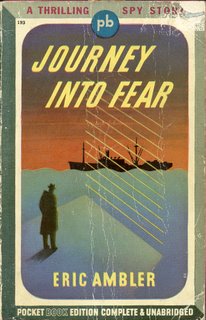
Last Tuesday I went to Focal Point to teach my perennial class The Contemporary Portrait Nude. I decided to take the B-Line bus which drops me off half a block from the school on 10th Avenue. The stop is right by a used books store. I always look in the window. I immediately noticed the Eric Ambler novel (sometimes called political thrillers), The Care of Time. I knew I was going to buy it for two reasons. I read any book by the English author who died in 1998 because he was my mother's favourite thriller writer. I may have been 15 when she handed me a copy of his A Coffin For Dimitrios. I re read it every few years it is that good. It begins:
A Frenchman named Chamfort, who should have known better, once said that chance was a nickname for Providence.

A Coffin for Dimitrios paved the way for my later appreciation of Ian Fleming, Len Deighton, John Le Carré and Graham Greene (in particular The Confidential Agent). The second and most important reason is that here was a novel by Ambler that I had not read. I opened the book and read the first incredible paragraph (above). I paid $4 for a first edition which is in reasonable shape. The photograph (seen here) of the author by photographer Stephen Cornwell graces the back cover.
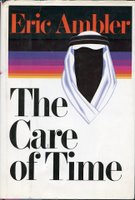
This novel, about a ghost writer who has a good reason to dislike both the CIA and the Iraquis, has a relevance today. Consider the second paragraph:
The message came in an ordinary business envelope that had been mailed from New York but had no return address on it. Inside, folded in three, was one of those outsize picture postcards that are offered to tourists in some places nowadays. This one was of a hotel with palm trees and carried an ornate caption proclaiming that it was the Hotel Mansour, Baghdad, Republic of Iraq.
Yesterday afternoon I visited my friend, photographer Raymond Lum. As a graduate from LA's Art Center he is very much like all the other graduates of Art Center that I have met. This means that Ray is most concerned with accuracy and perfection. With the advent of digital photography the pictures on his monitor have no hint of colours that were not in the original scene that he saw before he photographed it. His portraits have neutral gray backgrounds, blue shirts are blue with no hint of purple and skin tones are real enough to almost be uncanny.
Ray made an uncharacteristic mistake when he told me, "The difference between shooting RAW and a jpg (two different methods of storing the information of a digital photograph) is that RAW images have richer colour." As I admired Ray's realistic portrait of a real estate agent (Plato might have called it an essence of the real estate agent) I answered back, "Ray, I like your portrait because it is accurate. I am not interested in richer colour. I am interested in accuracy." One of the reasons Ray gets this accuracy is that he does not depend on a DSLR (digital single lens reflex) but has a scanning back attached to his Hasselblad. The pristine image of the real estate agent is a whopping 20 megabytes.
Looking at Ray's accurate portraits (he spends a considerable amount of money and much effort in making sure his top-of-the-line LED monitor is calibrated to his specifications at least once a month. Any picture that you see on his screen and one that he prints on his inkjet printer are virtually identical), I thought of the Acoustic Research ads of the early 60s that advertised a unique approach to sound. AR conducted a series of over 75 live vs. recorded demonstrations throughout the U.S. in which the sound of a live string quartet (The Fine Arts Quartet) was alternated with echo-free recorded music played through a pair of AR-3s. In this “ultimate” subjective test of audio quality, the listeners were largely unable to detect the switchovers from live to recorded, a strong testament to Acoustic Research audio quality. This was in an era before we began to boost bass, zing the higher frequencies and surround ourselves with sound or hear it inside our head from a little machine in our front pocket. A sense of loss in the original quality of sound has many an iPod owner docking the device into a tube amplifier that is supposed to uncompress the sound and return the original presence taken out during compression.
By the 80s, sound enhancement concepts had wandered off into the realm of photography. Film was made with punchy colours and increased contrast. There was slide film that gave people an artificial sun tan. It was advertised as having a warmer and rich colour. I had an admiration for the colour carbro process nude prints by Paul Outerbridge taken in the late 30s and 40s. Skin looked real. Instead of this accuracy we were fed high contrast and gloss by Cybachrome technology.
From his first 1936 novel The Dark Frontier to his 1991 Waiting for Orders Ambler wrote cool thrillers in which most of his protagonists were ordinary (in some cases colourless) people who more often than not accidentally got involved in situations that were completely beyond their control. One such man is Charles Latimer a lecturer in political economy who writes his first detective novel at age 35, called A Bloody Shovel. Latimer is the main protagonist of A Coffin for Dimitrios whose life changes when he meets (in Istanbul, naturally!) one of the most interesting and complex characters in thriller writing, Colonel Haki. The suave Colonel tells Latimer:
"I get all the latest romans policiers sent to me from Paris," he went on. "I read nothing but romans policiers. I would like you to see my collection. Especially I like the English and American ones. Al the best of them are translated into French. French writers themselves, I do not find sympathetic. French culture is not such as can produce a roman policier of the first order. I have just added your Une Pelle Ensanglantée to my library. Formidable! But I cannot quite understand the significance of the title." Latimer spent some time trying to explain in French the meaning of "to call a spade a bloody shovel" and to translate the play on words which had given (to those readers with suitable minds) the essential clue to the murderer's identity in the very title.
Much has been written on the excellence and richness of Patrick O'Brian's nautical novels. I, too have found them excellent and I have read the series twice. But this does not mean that I will forgo the enjoyment of C.S. Forrester's Hornblower novels. I find a telling connection between Forrester's Hornblower and Ambler's everyday men who rise to become heroes. I see a further link between Acoustic Research's (and Angel Records) penchant for accuracy and Raymond Lum's near obsession with the accuracy and neutrality of colour in his photographs.
It is almost impossible to understand what is in Hornblower's mind at any time because Forrester choses not to tell us. He does not colour or enrich the man with deep thought. It is there, but between the lines. The reader has to extract it. It is for this reason that Gregory Peck's performance as Hornblower is so perfect. We have to imagine everything in a glance or a pressing of lips. Ambler's description of Colonel Haki seems to be matter of fact but beneath it all is a man who is complex and scary. And much the scarier as we weigh him in our imagination.
I tell my students at Focal Point that unlike film photographers (as this one) they now have the power to record and display the colour and subtlety of human skin with a near perfection that was never there until now. So few of them take advantage or understand the gift they have.
Thankfully there are a few out there (Raymond Lum is one of them) who like Ambler, Forrester, and my Acoustic Research amplifier provide me with the richness (pardon me!) and the enjoyment of that which is plain and accurate.
The man standing in the shadow of the doorway turned up the collar of his overcoat and stamped his numb feet gently on the damp stones.
First paragraph, Cause For Alarm, 1945, Eric Ambler
‘You’re a hero, Winkie,’ said Coppy—‘a pukka hero!’
‘I don’t know what vat means,’ said Wee Willie Winkie, ‘but you mustn’t call me Winkie any no more. I’m Percival Will’am Will’ams.’
And in this manner did Wee Willie Winkie enter into his manhood.
Wee Willy Winkie - And Officer and a Gentleman
Rudyard Kipling
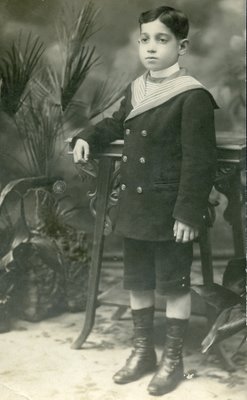
In the late 50s and early 60s Román Lopez Forment was a weekly guest for dinner at our home ( I lived with my mother and grandmother in Mexico City). Román's mother, Josefina, was my grandmother's sister. She had been widowed in the Philippines so she moved to California with her daughter and five sons. It was there that her sons were adopted by a mafia don.
Román, who as a young boy had had unruly curly hair that made him resemble a Polish pianist and composer, Moritz Moszkowsky was given the nickname Moszkowsky and was a favourite of my grandmother. He quickly became one of my favourite uncles because of his stories of life in California in the 1930s. He and his brothers had money (the mafia don?) so they drove Dusenbergs, Auburns and owned yachts. They wore white slacks, played tennis and did not work much. There were many women. Román scandalized his family by marrying his manicurist who was a Mexican born German. Bertha and Román moved to Mexico. I was never smart or curious enough to find out what happened at the end of prohibition if that is were the Forments lost their regal family fortune. Bertha and Roman had two daughters and three sons and lived in the working class neighbourhood of Tacubaya. It was in Tacubaya where in the American British Cawdry Hospital both my daughters, Ale and Hilary were born. I remember vividly visiting them one day. A relative of Bertha's had appeared driving a Taunus. Bertha proudly told me that it was a German Ford.
When I was 14 Román's brother Vincent sent his son Bryan to stay with us. Bryan developed a terrible toothache. My mother sent him to the dentist. It was a terrible abcessed tooth which the dentist removed. We never heard the end of it as Bryan's father was a Christian Scientist. He told my mother that we should have obtained his permission if Bryan was to see a doctor. I remember this all very well because it was during those days that I had gone to see Grace Kelly's (the love of my life at that moment) last film, The Swan with Lois Jourdan and Alec Guiness (who played the prince who in the film accomplishes what Prince Rainier did in real life, take Kelly away from us!). I had gorged myself on a huge bag of pistachios and was so sick I did not eat a pistachio until last year. Bryan laughed when I mentioned that I loved Grace Kelly's neck. Bryan was more sexually precocious than I was and he suspected (rightly) that I did not know the meaning of the verb form, to neck.
Years later in 1967 I visited Vincent (my uncle Vincent who lived in Milbrae, California. Bryan was in college. Of the visit I remember nothing but I do remember visiting Vincent's brother Ralph who lived and lives in Stockton. He invited me for a barbecue in his backyard. As he was pouring soy sauce on the meat ( I had never experienced the custom of putting anything on cooking meet except salt, after all I am Argentine) I was astounded to see an ocenan liner parade past on the other side of my Uncle Roman's hedge. While I had recently attended a performance of Jefferson Airplane and I had marvelled, during the performance, at the sight of a pretty young girl in a corner staring at the greenness of her tiny glass of Crème de Menthe for what seemed hours, I could not believe my eyes. It was then that Uncle Ralph explained that Stockton was a sea port because of the ship channel and that the channel in question was in his back yard.
It is only now that I am 65 that I am curious enough to want to know who the mafia don was. Where did the money come from? Where did it go to? I had my chance a couple of years ago when cousin Bryan Forment and wife (out of the blue) visited me from San Francisco. He explained how his grandfather had had constant visitors who would kneel in the presence of his grandfather. I never asked. Bryan died last year.
His daughter Page and her husband Charlie Berghoffer (they live in Redmond, Washington) visited today. They don't know the story. I wonder if I will ever know.

Page and Charlie asked me if I was going to add (handwritten by my mother) to my mother's fold out family tree where I showed them how I was related to the Forments. Looking at their young and enthusiastic faces I probably brought them down by telling them that nobody in a few years would care and our decendants would then create their new family trees and we would be in a distant but forgotten past.
I was lucky enough to have an Uncle Román who visited and filled my head with wonderful stories. Could such wonderful stories entertain Rebecca? Can stories be stories if they have no special effects? I suspect it is yes. Lauren and Rebecca had a sleepover with us last night. I had to pick a movie we could all watch. I went to Videomatica with the idea of selecting the 1971 version of Kidnapped with Michael Caine. But I returned with John Ford's splendid Wee Willie Winkie with Shirley Temple, Victor McLaglen and C Aubrey Smith. But it was Cesar Romero's Khoda Khan, the rebellious revolutionary from Northern India that made Rebecca remark, "He is very good looking." This he was and we all (including Lauren) enjoyed a film in which Kipling's original protagonist Percival William Williams somehow becomes an extremely cute Priscilla Williams (Shirley Temple). Kidnapped may have to wait as more Shirley Temple will perhaps be in order.

Yesterday I wrote about the epimedium and how I call it the Cinderalla of the garden. It's not there until you notice it. A plant, that is quite the opposite, owu with a flower that screams at you is the rhododendron. There are over 1000 species in this genus. There is an incredible variety ranging from whites and pale pinks and off whites to the most lurid oranges, reds, shocking pinks and purples. It is unfortunate that in Vancouver during the 50 and the 60s the most popular rhododendrons were plants that were bred for colour without any consideration of scent (there are some sweetly scented rhododendrons). These hybrids are pretty well indistructible, mostly disease free and faithfully bloom just about now. There are several in my garden and when we bought our house back in 1986 we could have gotten rid of them. I simply can never get rid of a plant unless it dies. And now when I have come to find them unsightly it is much too late. If I take them out it would take years for species rhododendrons to bulk up to size. Rosemary and I will have to ignore the "loud" screams from these plants.
Rebecca appreciates and loves rhododendrons. I have taught her to pass her fingers under the plants in the rhododendron walk in VanDusen. Many have an underside hairy substance under the leaves called indumentum. The colour can be white, pale white and many times a rich cinnamon brown. This indumentum can be very soft and it feels like the inside of a cat's ear. In our garden we do have Rhododendron luteum formerly Azalea luteum until botanists upgraded them to rhodos. Rebecca knows that when this rhododendrum blooms in about two weeks the yellow flowers will be extremely scented and when they beging to decay they paradoxically smell more strongly and more sweetly.
The mature hybrid rhododendrons in our garden are here to stay. Perhaps I respect the taste of Mrs Young who lived in our house for many years. Perhaps there were few species rhododendrons being sold and she only bought was was in the market.
Rebecca and I will simply have to visit that other garden of ours, VanDusen Botanical Garden and enjoy all those hairy leaves and sweet scents. They are our plants, too.
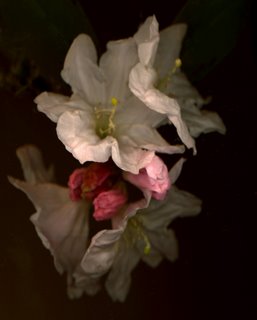
And when Rebecca and I want to smell Rhododendron decorum whose white flowers smell like ripe watermelon we can always visit our friend, gardener Pamela Frost who has a couple in her garden which she planted from seed. As the buds open they go through many colours before they finally become white.

Our garden is a May to end of August garden. This is because that's when the roses bloom and hostas flower in June/July. There are some gardeners who want a 12-month garden. The work that entailes is really beyond the capability of two of us. Besides we want to rest from the garden and we are sure the garden wants to rest from us. As the garden decays in late fall I even enjoy the decay and the falling leaves. There is beauty in death.
We are about to enter May and that is when the fresh shoots of my hosta emerge in their pristine green or light yellow. They are wonderful, and as wonderful as the unfurling ferns.

But there are some plants which I call the Cinderella plants. Nobody notices them. This is because they bloom quietly about now when I am not looking for flowers. One of the Cinderella plants is the Epimedium. This Epimedium, Epimedium x rubrum caught my eye today. It blooms before the new leaves are out. In a few weeks when the leaves emerge the flowers will be invisible, covered by the hostas and the ferns. The flowers are no bigger than the nail of my smallest finger. They look like little stars or little space fighters in a science fiction film. Perhaps epimedium has been damned by being considered a ground cover. Can any other name condemn such a plant? Perhaps I will notice it a bit more from now on.

In the mid 80s Vancouver had a reputation for beautiful women who had been discovered and then posed for Playboy Magazine. In 1983 Vancouver Magazine decided to do a story on four of them. I was assigned to photograph them and Les Wiseman wrote the story. They eidtor and art director felt that if the local photographer and Playboy talent scout Ken Honey photographed them the material would be too racy for a city magazine.
I had watched Ken Honey in action at Wreck Beach. To be fair he was nude too while he walked around with his camera. His favourite mode of operation was to approach large breasted women who owned dogs. He would pet the dog and start a conversation. While he did this he checked for droop. I talked to a few who had told me, "Ken chatted with me but then he suddenly went away. I knew it had to do with the droop of my breasts!"

Of all the Playboy Playmates I got to meet and photograph for the article (some refused to be photographed) the most interesting was Kelly Tough. She was friendly and really seemed like the girl next door until you noticed her chest. I took photographs of her at home and used her flowery wallpaper as a background. The art director, Rick Staehling sent me back for a re-shoot. It seems my pictures weren't glamourous enough. I don't recall what he said to me but it was something like, "You have some good material do work from. I am sure you can do better."

At the time I used umbrellas instead of soft boxes. I really had no clue how to shoot glamour and I made the mistake of positioning my umbrellas a bit too far so that the lighting was a bit flat. But my flat lighting made the playmates' complexion look extra smooth in that pre Photoshop era. We didn't really have to resort to air brushing.
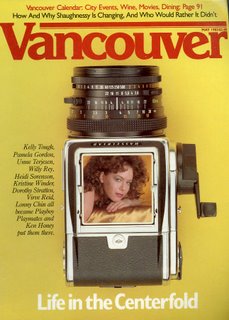
Looking back at those 1983 photographs I see in them an innocence of an age and my own. I remember asking Les Wiseman (certainly more worldly than this Catholic educated photographer) about pornography here. I remember looking at Kelly Tough strangely but she quickly set me straight. She was kind and easygoing and most cooperative in spite of this stumbling photographer.

She looked at my Polaroids (left) and gave me constructive criticism. She made me relax. I became a fan and felt most jealous when a legion of photographers snapped her picture at the PNE!

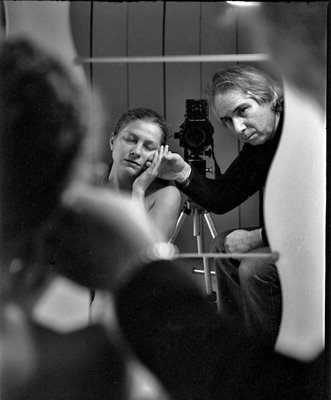
I first met Yuliya at Focal Point a few years ago. She was the model in one of my classes. She has been our favourite model since because unlike other models she shows up on time and never fails to appear. I have written here before about the relationship between a photographer and a model. I have a similar longish photographic relationship with Yuliya (she is from Ukraine, and is visibly annoyed if you happen to say, "the Ukraine"). She shows up at my studio every 6 months and we shoot for fun. But it isn't too much fun as she is demanding, critical and doesn't like any of the pictures I take of her. I wonder why she keeps coming back for more?
But she did like the combined self-portrait you see here. I have taken some before and of them Yuliya has said, "You were nervous and stressed out in my proximity and the picture is no good." How is one supposed to feel in the presence of a beautiful woman who is not wearing anything, particularly when I know that one of the most sacrosant of my shooting rules is that I never touch? She insisted on this last one and posed me for it. It was at her Burnaby basement suite and she had a curvy mirror on the wall.
She did not like any of the pictures that I took that day a few months ago but of this self-portrait she said, "It is perfect."
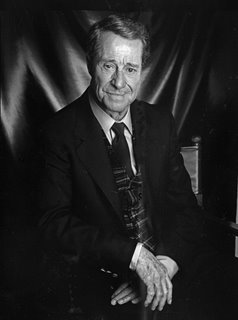
Yesterday Rosemary and I sat down to watch Mitchell Leisen's 1939 film Midnight (it first opened at the Paramount on Broadway in April 1939).
While Rosemary set up our clandestine TV trays I boiled gnocchi and mixed it with green peas, chopped raw onion, butter and Maldon Kerala pepper. On this I sprinkled just grated Parmesan cheese and crumbled three pieces of thick bacon. We sat down for what I knew was going to be an extremely pleasant experience. Can you imagine a film with Don Ameche, Claudette Colbert, John Barrymore (who played the fairy godmother) and Mary Astor (her usual devious self)? And consider that one of the script writers was Billy Wilder.
This film had all the class and comic touches of another director of the period, Ernst Lubitsch whose 1939 Ninotchka, with Greta Garbo and Melvyn Douglas is another favourite of mine. I despair that if I watched this with Rebecca she might not understand the communist commissar aspect of it and not appreciate how Garbo breaks down and softens up. Does a 10-year-old know about the Soviet Union, communism and the bourgeoisie?
It is perhaps an obsession of mine that when I watch a film I always wonder if it would be one that Rebecca would enjoy and appreciate. With so many "crass" remakes of Cinderella in a modern world urban setting this one, Midnight, is set in Paris and the Ritz (populated by people who played bridge, drank Champagne and had no visible means of earning an income)and with a dashing prince (Don Ameche) who is a hungarian cab driver just might teach Rebecca what class is. And I will have to introduce her slowly to the real reason why Midnight is such a hit. Claudette Colbert plays an American small town gold digger who wears satin with panache and oozes the experience of woman who has seen the world, known her men and how they affect her and become all the wiser.
And how can I teach Rebecca to appreciate films in which:
1. There are no special effects.
2. There are no real villains.
3. Nobody is shot, killed, maimed or blown up.
4. And, principally, that the fairy story ending is far more believable than the special effects of contemporary films.
I was unable to explain to Rebecca last Saturday that going to Ballet BC's Peter Pan was a special occasion that warranted getting dressed up. Her parents did not seem to understand either. I explained to Rebecca that many of the girls who had dressed up rarely went to the ballet. The ballet is expensive and we just happen to have friends in higher places and thanks to photographic trades I am able to go to these events more frequently. Dressing up for the ballet is like drinking Coke from a Champagne glass. It tastes better.
Watching Claudette Colbert and Don Ameche spar in a taxi (with wonderful headlights esconced inside the grille. What car was it?) is very much like drinking that Coke in a Champagne glass. It is so much better than anything that is attempted now.
The original film review in the NY Times by Frank S. Nugent can be found here. It is my hope that this lovely review will open to all of you who might try. The review itself has that class, that dressup class that has all but disappeared.

For some time I have had the suspicion that all was not well with the appearance of this blog. Since I am stubborn, I dismissed the fact that my pictures always looked pale on someone else's monitor simply as the result of improper monitor calibration on their part. I insisted, to those few who pointed it out the paleness, that my monitor was properly calibrated and the pictures of my blog looked just right.
But I should have suspected from the beginning that my aging cathode ray tube monitor (a used Dell) could not really be properly calibrated.
For those who might be confused by the above let me give an explanation. When a photographer uses film, for better or for worse, the hard copy result (slide, colour negative or b+w negative) is an accurate record of what the photographer saw if the photographer strived for photographic accuracy. Transparency material (larger slides, and slides in general) tend to make shade blue. My Ektachrome has been rendering the gray background of my studio portraits to various shades of "Ektachrome blue". High saturation colour film makes greens (lawns for example) greener. In short colour film, even when properly exposed, is not accurate in the display of colour. One very important reason is that film (all kinds) have an extra sensitivity to ultraviolet light. Film and the human eye perceive light and colour differently.
Accurate or not, when I handed in a slide to a magazine art director, the slide served as a standard for the magazine printer to go by. The art director could have either cooled or warmed up that image for personal preference. Sometimes art directors will do that to balance the look of a two-page spread (as an example) where two pictures, one cool in colour and one warm might clash seen together on the page. Our perception of colour is subjective.
Photographs can be light or dark. Some are shot dark on purpose, perhaps for drama, or dark by mistake because of underexposure. The portrait of a baby might be rendered slightly lighter and in a pastel colour to convey the idea of innocence. In pornography the colour of "bits and pieces" might be darkened for effect. When I print my b+w negatives in my traditional darkroom I have perceived periods where I tend to make my prints dark and contrasty. These periods have alternated randomly with times when I have printed paler.
But always the slide or the photograph (colour or b+w) is the ultimate record and standard of the photographer who has taken it.
With the advent of the digital age all this has changed. The photographer who shoots with an expensive DSLR (digital sinle lens reflex camera) has no hard copy original. The original is a series of zeros and ones captured by a sensor and stored in the camera's memory. In a wonderful way this stored image, particularly when the photographer does not "cheat" and does not look at the image on the back of the camera right after an exposure (this practice of looking is called chimping) displays all the potential of that wonderful world that came into being with photography in the 19th century. This is the latent image. The image that is there in our imagination and in the unprocessed film stock (if we are lucky!). The image that we think we have captured but that has to be "developed out" or processed before we can see it. A roll of exposed b+w film (as an example) when held in your hand it is pure potential. It is the potential of latent images waiting to see the light of day.
When a digital camera photographer finally "opens up" the taken images the "original" is an infinitesimally thin image that sits on a monitor screen or on the LCD screen in the back of the camera. When the photographer (let's suppose the photographer is a magazine photographer) sends images to a magazine art director by email, the original image that can be used as a standard has to be (there is no other) the image sent. This image can vary if the photographer and the art director's monitors are not calibrated equally. And if the monitor used by the magazine printer is different, that will also stretch the problem of reproducing an original as the photographer saw it, or thinks he or she saw it, or as he or she thinks it should have been by introducing modifications with PhotoShop (in itself just a super flexible version of darkroom manimpulation).
The above is to explain that until yesterday most of the images of my blog have been too pale for most who have perused my blog. Last night I darkened a couple of week's blogs. It was labourious particularly in the multi picture blogs with 5 or 6 pictures. I have to remove and re-insert each one, one at a time.

For close to a year my monitor display has been the above picture of Rebecca and Lauren taken in the summer of 2006. For that year the picture looked just right on my monitor. This is what it would have looked to all of you had I inserted it into my blog.

Magnolia stellata grows wild in certain parts of the Ise Bay area of central Honshū, Japan’s largest island, at elevations between 50m and 600m. It grows by streamsides and in moist, boggy areas.
Our Magnolia stellata (Star Magnolia) came from a nearby garden. The house was being torn down. I asked the crane operator if I could help myself. With a smile he nodded in the affirmative. The magnolia replaced a dead Lawson cypress by our kitchen bed that had died of root rot. Our garden when we purchased the house in 1986 had at least 8 of these cypresses that have succumbed to root rot. We have been replacing them as they die with other trees. The magnolia for me has been a tree of fascination because of its great botanical age. There are fossilized specimens of Magnolia accuminata that date back 20 million years. Magnolias were flourishing before bees so the flowers are designed to be pollinated by beetles.
Our stellata is in bloom right now and it has never looked better. The reason is that it has not rained. Rain makes the stellata blooms look like sickly droopy mess.
I associate our stellata with the name of an Argentine navy chapel in Buenos Aires called Stella Maris. It took a while before I figured out the name. Stella Maris (or Star of the Sea) was the name sailors gave the Virgin Mary. Of all the armed forces of Argentina, it is the navy that is the most Catholic. When Perón started burning churches in 1955 the Argentine Navy began the rebellion that ultimately toppled the dictator.
Yesterday Rebecca, Lauren, Rosemary and I saw Edmond Kilpatrick's last dance performance, as Captain Hook in Ballet BC's Peter Pan. He is leaving Ballet BC.

It seems that since I first started taking photographs of Ballet BC dancer Emdond Kilpatrick back in 2000 he always posed for me with a woman. Paradoxically it was when I took his picture in my studio with dancer Connor Gnam (then with Arts Umbrella) that I realized his ease in fitting in not only with ballerinas but with male dancers, too.

It was Kilpatrick who started in Vancouver a program to entice young boys into ballet and dance while at the same time showing them the respect that a male dancer deserves in this day and age. And it was watching Kilpatrick teach a class at Arts Umbrella (my Rebecca was in that class) that I noted his blend of gentleness (he never raised his voice) and his absolute demand for perfection. Rebecca complained he was too demanding. I smiled when she said this as I know that if a 9 or 10 year-old is not pushed she will do nothing and just get by.
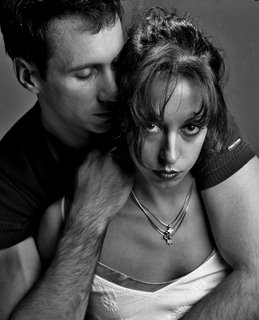
In the 8 years that I have observed Kilpatrick I noted that he was one of the few (besides Jones Henry) who was able to pick up the almost as tall Emily Molnar. It was Kilpatrick that enabled Alleyne to choreograph for that stupendous dancer that Molnar is. At first I was turned off by Kilpatrick coolness. His dance seemed to lack passion. But then I noted how this coolness made the women react with passion as they danced with him. His Don José in Alleyne's Carmen was just right to Sandrine Cassini's Carmen (third photograph from top). When he eventually sticks the knife into her it was believeable. The cool man had snapped. When I photographed Kilpatrick with Cassini and Acacia Schachte for Carmina Burana it was Rebecca, who was present at the shoot, who noted to me the attraction that women had for him.
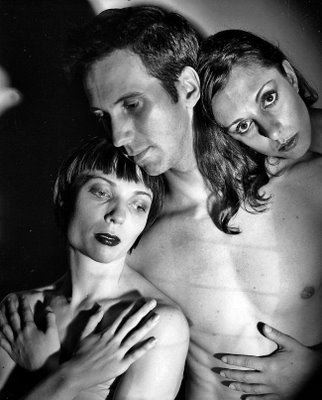
If anything Kilpatrick has represented to me the cool jazz performer who smoulders on the inside. This coolness has not prevented me from finally realizing that part of it is due to a shyness that he has somewhat not shed yet. Yet when he does smile (something that seems to not do often) it is an easy and warm smile.
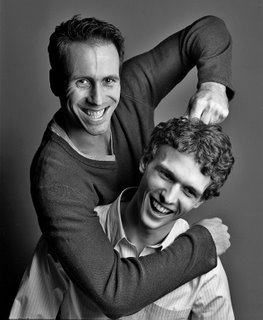
I remember that when Kilpatrick emerged on to the dance scene in the late 80s every female publicist, every female dance critic or arts writer/editor fell for his charms even to the point of swooning is his presence! I know because many of them confessed this to me. So when I had my first chance to photograph Kilpatrick for the Georgia Straight, I asked him to bring his Russian ballerina wife Victoria(the first two photographs above) to our studio session. I am sure that many women will miss the strong, tall and cool presence of Edmond Kilpatrick in Ballet BC. I can add that this man will miss him, too.

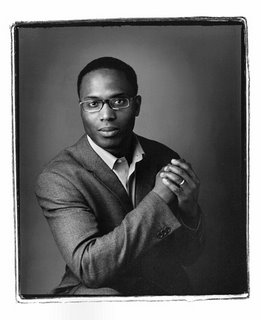
Of late, trying to take Rebecca to dance, to concerts or to theatre has been a hard sell. With slight encouragement from home and the stressing that I am a tad too agressive on taking her to cultural events she has rebelled. To show her rebellion she chewed bubble gum and blew bubbles during Michale Jarvis's exquisite harpsichord solo in Bach's Brandenburg Concerto No 5 some weeks back.
The only reason Rebecca came along with Rosemary and Lauren to yesterday's matinee performance of Ballet BC's Peter Pan (choreographed by Septime Webre) was that her mother insisted on it. We attended the pre-ballet talk and Rebecca was the only person to ask a question. I was proud of her poise and unshyness.
A few weeks back I might have muttered (perhaps Rebecca is right and I am on my high cultural horse) on how could John Alleyne offer Peter Pan when the Alberta Ballet was working on a second ballet involving Joni Mitchell. I read in the New York Times how the Kirov was featuring ballets by the noted American choreographer William Forsythe. Why Ballet BC had performed various Forsythe ballets before the Kirov knew who the man was.
Now I can see Alleyne's wisdom. At least from the point of view of not only delighting Rosemary and Lauren (and this recalcitrant high culture guy) but Rebecca, too. Rebecca insisted on spending $10 (a bribe from Rosemary for her reading and finishing two books last week) and buying a stuffed ballet bunny ("So that I can remember that I came with you to see Peter Pan."
We had a delightful time, we laughed at the ticking crocodile and laughed even more when the crocodile (Peter Smida) danced a Hollywood style tango with Captain Hook played by Edmond Kilpatrick.
Thanks to John Alleyne and Ballet BC I have been given enough cultural amunition to fight another day!
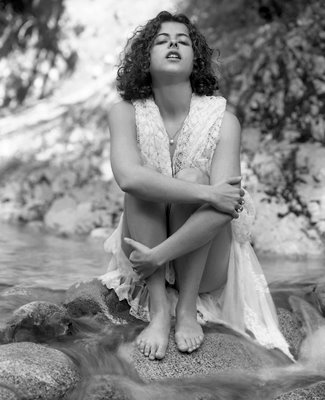
I have written about feet here, here and here. And Max Wyman wrote about feet here.
I will still not admit that I find feet in any way attractive. It all happened some years ago when a very pleasant female photographer told me, "Why don't you photograph feet?"

Immediately, I replied that I found feet the ugliest part of the body and that I also did not want to fragment the human body into body parts. I remember sharing a photographic shoow with another photographer some years ago. Both of us had nudes on the wall. In those years of femenist awareness I will never forget the woman who left a statement in the gallery guest book, "Waterhouse-Hayward, thank you for showing us the faces." Since then I have tried not to depersonalize the human form by stressing the parts.
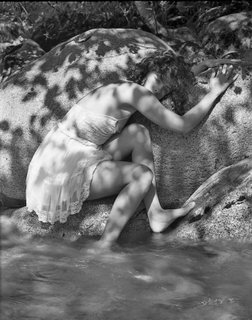
At Focal Point I teach a somwhat popular class that I have purposely called The Contemporary Portrait Nude. I tell my students that even when they are taking pictures of our model's hands or feet they must not lose sight of the model's humanity and individuality. I stress calling the model the subject as the latter word does not include the idea of models with all our prejudices that we may direct at the meaning of that word.

And so against my inner desires to not photograph feet I have done so for some years. My favourite place has been Lynn Canyon in North Vancouver. The rushing cold water seems to add excitement. Some of the best and most erotic pictures I have ever taken were of the jewelry designer Susan Fiedler.
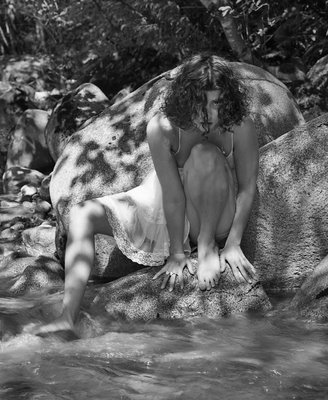

Susan Fiedler - A Face

I have been thinking about beautiful women recently. More so today after having seen with Rosemary, White Cargo yesterday. White Cargo (1942) stars Walter Pidgeon, at his best, and Hedy Lamarr at her most beautiful. I have been thinking about beautiful women because in my two previous blogs on them I hardly ever knew them as they faced my camera. With Patrice B it was different.

I hinted a bit about her here. Looking at here files again today some of the bits and pieces that I remember about the session with Patrice have come back. I don't remember why exactly she chose to bandage her hands. "I want to feel like a boxer," she said. But I do remember that she was having to make decisions about her life.
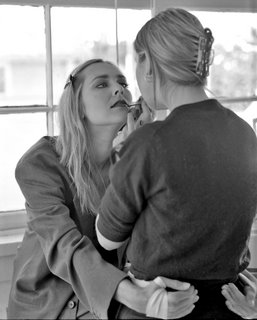
One of them involved moving to the United States the other one had to do with either dumping her boyfriend or being dumped. While she asked me to photograph her nude she also indicated I take other pictures. In some I used my flash but in many the mottled lighting that was coming in through the windows was the single light. Looking back I can only now see the pattern.

There is a man's coat, trousers, sweater and socks. In some of the pictures she would smell intensely the sleeve of the sweater. While I cannot show some of the best nudes I have ever taken in my life here I can give a hint at the incredible gift of being able to observe a woman's itimate thoughts displayed through gestures, clothing and lack of it.


As I photographed Patrice I never thought that she had any resemblance to Cybill Shepherd. Now as I look at these photos I would say to the contrary. Shepherd looks like Patrice but is not as beautiful as Patrice.



My friend Ian Bateson used to drive me crazy when I would show him what I thought was an original and well taken photograph that I had taken recently. Invariably he would look at it and say, "It's been done before." He had me frustrated for years until one day I saw the light. I showed him a photograph and he said the predictable. This time I countered with, "But I have not done it yet!" I may have shouted this at him I was so excited at finally arriving at this piece of photographic wisdom. Since then Bateson has become a most supportive fan of my photography. I hope he understands how instrumental he was in my progress.

At least a decade ago I had two successful gallery shows. One featured a woman, Lisa Montonen holding different hosta leaves from my garden. I took them all in one afternoon in my studio and used only one light. The other show were portraits of women in tubs, all taken from the same angle and revealing nothing that would offend anybody. The lighting was much more complex but I knew what I was doing, or at the very least I knew what I wanted.

The testing, with all its mistakes of lighting, shooting angles and lack of direction, I imposed on brave women who posed for me in previous years to those shows. They knew I was experimenting with lighting schemes and approaches and patiently posed while I blundered. One of the most patient and one of the most calmingly beautiful was the late María de Lurdes Behar. Here you see my early examples of shooting a woman with a hosta leaf. But she did manage to be around to be part of my tub show. It was so charming to photograph a woman so tiny that she could easily bend into a fetal position in a very small tub.
The above is an explanation on how all photographers must go through a transition. They all must put their hand into the fire and feel the burn. Advice from others will never do. Photographers must experience it themselves. By their mistakes they will learn what not to do. When those mistakes become accidental successes the photographer, if methodical can track back to see how the mistake happened so that it can be repeated!
My photographs in yesterday's blog represent a transition in my approach to taking pictures of women. For my 21 first century tastes they look much too glamorous and devoid of substance. I would never photograph anybody in bed smoking. The romance of the woman smoking in bed is long gone. While the pictures of Vantana are not too revealing because if have pledged to keep my blog at a standard that it should not offend my granddaughter Rebecca (even though she has seen most of my nudes) or any of her friends. In one of the photographs posted yesterday I actually removed all traces of an "offending" nipple.
In order to photograph those pictures of Lisa Montonen with my hosta leaves I had to first experiment with the mottled lighting that I used on María de Lurdes Behar. It was too difficult to use. Depending on how the mottled lighting fell on her face it made her cheeks look big. Lisa Montonen had very blonde hair so I was able to separate her from my dark background without having to use a "glamorous" hair light.
Vantana's photographs were such a transition. They almost make me cringe when I look at them. But such was her beauty, her long legs, her high cheek bones, that my ineptness and innocence luckily did not carry the day.
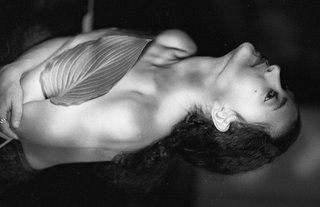
Four years ago Rebecca, Rosemary and I went to Buenos Aires. I saw many ads of women in bikinis advertising everything from tootpaste to Fiats. The ads looked to this proper Canadian, obscene. I commented on it to my relatives. My rugby playing nephews thought I was insane and questioned my manhood. I tried to explain the concept of political correctness. I asked them exactly what the connection, between a beautiful woman in a bikini holding tootpaste, was with tooth decay. In the end I gave up.

When I first met the tall Vantana some years ago, she reminded me a bit of Geena Davis. I proposed to her the idea of taking her picture in room 618 of Tony Ricci's Marble Arch Hotel. She agreed but warned me that she had recently cut off and bleached her wonderful hair. I wasn't going to wait for the hair to come back so we met at the Marble Arch.
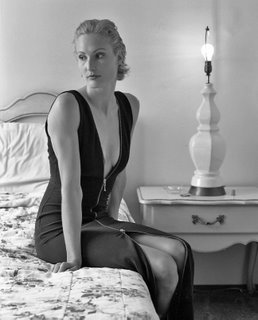
For laughs I brought my dark blue pin stripe suit, a white shirt and braces. We took pictures in a room where I had photographed quite a few women before and a quite a few after. I was still experimenting with lights and no lights (some of these are long exposures with my camera on a tripod, using the light that was available in the room).
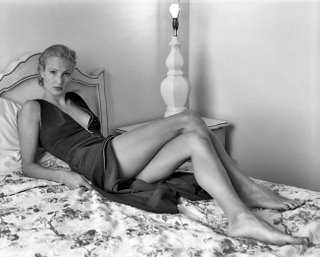
I followed my friend John Armstrong's idea that a lamp without a lampshade made pictures look a tad cheap and noirish. I have never used these pictures for anything but they certainly helped me progress in perfecting my style of photography.
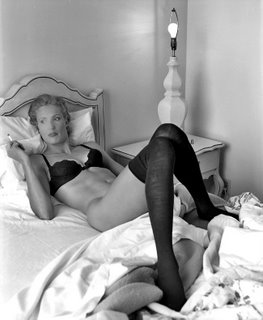
I now use my light a lot closer and get more shadows. It is close in look to the one you see here where Vantana lifted the braces up to her shoulder. I was rendered speechless when I saw this.
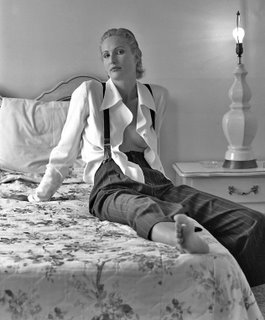
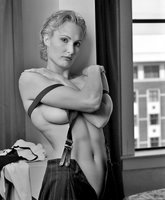
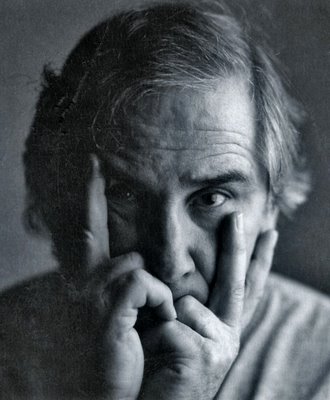
There are several acknowledged rites of passage. The most important one (without which further rites become moot) is being born. My only proof of that event, now that both my parents are dead as well as others who might have attested to that event, is a tattered document that I had to translate on the spot for a kindly woman from Fiji (not so kindly and beaurocratic in her demeanor until I made her laugh with my chatting) at the Canada Government building on Quebec and 10th Avenue. I was there today to get a lesser known rite of passage, my Old Age Pension and my Canada Pension, that because I speak the language I was able to perform alone without company. There were quite a few elderly Chinese men accompanied by younger women, perhaps there to obtain the same service. This rite of passage is bound to be a unplanned harbinger of that final rite of passage in which we all leave unaccompanied, too.
Rosemary filled out the application forms and told me this sort of thing makes her very nervous. We have crossed too many borders in Latin America and Europe so her fear of application forms and government bureaucracy is not unfounded. Mine borders on the phobia.
As a child I never understood my mother's instructions when going to the Buenos Aires Police Department (part of the reason why I am afraid of going to government offices even now)to obtain some document, to affirm that my surname was Waterhouse-Hayward while hers was de Irureta Goyena. I was too young to understand the problem of Argentina not recognizing my father's divorce before he married my mother. I also had to memorize a different birthdate as my father had botched that and registered me almost a year after my birth.
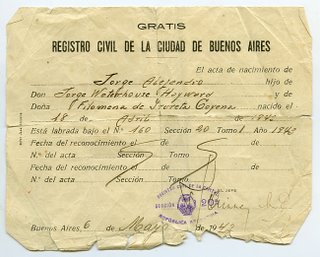
The worse case was the scenario at the Mexico City airport sometime in 1956 when I flew in from school in Austin. The man at immigration said, "Young man it is impossible for you to be entering Mexico as I have no record that you ever left it." The mistake of a lazy official who had not stamped my leaving Mexico a few months earlier cost my mother many pesos in lawyer's fees and mordidas (bribes) to set the record straight. It also involved lineups at the notorious Gobernación on Bucareli Street where all residents of Mexico who were not citizens did their trámites ( a horrific Spanish word for official paperwork that includes the concept of long waits at lineups and being subjected to surly officials who think they are God. As a matter of fact there is a way of talking to these officials that necessitates the use of the subjunctive mood. It is a bureaucratic Spanish that makes Dickens's Uriah Heep seem even more odiuous when translated into the language of Cervantes.
"Should you in your kidness take my problem at hand, would there be a possibility that with God's help and your invaluable contribution to my affairs my application form might be seen by Mr. Perez before the end of the month? I would be eternally grateful to you and I would find a way of proving that. Perhaps I could help with a contribution for your forthcoming vacation trip to Acapulco with your dear family."
If the above did not help then one hired a coyote the deprecatory name given to men who would intercede (a go-between no less hated than a procurer) through connections to speed up paperwork.
My paper work at the Canada Government Office was a breeze. As soon as I told my Fiji born (of Punjabi heritage) official how my father had invited his friends from the Indian Embassy in Buenos Aires to a curry dinner cooked by him at home, she was mine. She had initially told me, most coldly, when she saw my documentation, "You wil have to have these registered for authenticity, etc." By the end of the interview (after I had told her in great detail a typical Argentine meal and how to cook it) she had stamped everything and told me, "Thank you for making me laugh."

I remember the day that I spotted the once scary (only to me it seems) Joe Shithead outside my Burnaby home so many years ago. "Alex, we need you to photograph DOA for Interview Magazine," he said to me in his blasé way of saying things. Joe has always been straightforward about this sort of thing and indeed soon after I had a full glorious page in Interview Magazine with this picture. The other side of the page was a smaller picture (ha!) of the American punk band Black Flag.
As a photographer I am living in an age of chaos, less work, a decline in magazine work and the dumbing down of lighting so that everything looks like Flickr. The uncertainty of my profession just when I have received my Gold Card and perhaps a $200 government pension is stressful.
Yet, a week ago, last Sunday, there was Joe Kiethley and his band DOA in my studio. Joe had hired me to shoot the back cover photo for their upcoming CN Northern Avenger. What were the chances in our changing times and a music scene in turmoil that both Joe and I would be in my studio at the same time so many years later shooting for a CD? Whatever those chances might have been I am grateful to Joe and DOA for bringing a bit of calm to my unsettled life. How many people could say that about a punk band?
Thank you Joe for you perseverance, for not losing your way and specially for that evening of calm.
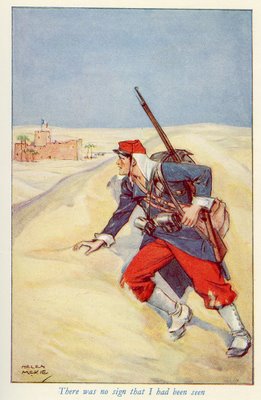
There are those stories, the true ones and the ones that are not, of the-soon-to-be blind person who travels the world to see all. And there is the not quite historically correct concept of the barbarians at the walls of Rome. When they breach them the world slips into the middle ages and the lights of learning turn off with a few beacons being kept lit by Arabs scholars who translate the Greeks and the Romans into their language.
I think of all that as I gaze upon Rebecca and remember the film Charly. Cliff Robertson plays a man with a child-lie maind who is given a drug that makes him brilliant. But as the drug's effect begins to wane he now understands what it is that he is losing. He is losing something that he never had. And that is what makes this film one of the most tragic I have ever seen.
Perhaps I am over dramatizing this (I surely am!) in my quest to expose Rebecca to as much knowledge, situations, experiences before her teenage "middle ages" come crashing down. We can all see it coming. Last night she did not want to see Liszt's Rhapsody the film for children (and adults) from the series on composers. We have seen the ones on Handel, Bach, Beethoven and Bizet. Rebecca wanted to go home but only under the insistence of her mother, Hilary did we sit down to watch and Rebecca had no choice. As soon as the super handsome Geordir Johnson (who plays Farzn Liszt) appeared I watched Rebecca from the corner of my eye pick up the DVD case and read the credits. In the end we had a pleasant evening and we all learned something.
My daughter Hilary seems to have some sort of chip on her shoulder that I was not as insistent on the concept of culture and the educational when she was Rebecca's age. She is, of course, absolutely right. What could I have possibly known then? I may know just a bit more now but in our changing world I have come to the realization that knowledge of the esoteric (that which was not so just a few years ago) is a valuable commodity. My friend Abraham Rogatnick and others say I must go easy and not push. But the fact is that the change in Rebecca becomes obvious from one day to the next.
On Friday we attended a concert at St Jude's Catholic Church that was performed by Paul Luchkow, Michael Jarvis and friends. Rebecca insisted in not only chewing gum but blowing bubbles, too. Since we were only a few ft from violist Glenys Webster I could only wonder how it might have affected her playing (it didn't as far as I could ascertain). But I didn't say much. Rebecca had come to the concert and who knows how many more she will attend before the curtain of culture comes crashing down!
At the intermission I asked Glenys to chat with Rebecca. This she did and Rebecca also listened as Michael Jarvis explained to a little audience how his harpsichord worked.
Liszt's Rhapsody became a distant second choice to the film Rebecca really wanted to see Arctic Tale . At the very least Rebecca's original choice was educational. But this word is now a suspect word in our family. It represents something boring and tedious that I try to force Rebecca and Lauren to experience.
I think of the film Beau Geste where the only special effects is the problem of giving a dead legionaire a Viking funeral (complete with burning long boat and a dog at the dead man's feet) in the middle of the desert. The solution is an intellectual one. Intellectual special effects are now pennies in a Loonie currency. They do not hold their value.
So I live in a small fear that while I was under 10 when I first saw Beau Geste with my parents I might have to wait a bit longer to see it with Rebecca. It would break my heart if she soon grew bored. For years (she was past 20) her mother Hilary refused to see The Third Man because it was in ugly black and white.
But there was a glimmer of hope as I experienced a moment of paradoxical sadness mixed with joy. I was in the boulevard shoveling sand into my wheelbarrow when I heard Beethoven's Moonlight Sonata. I thought immediately of my mother who often played it and was hit by a wave of longing for her. But then I knew that somehow it was Rebecca playing it on the Chickering and that the living room window was open because of the warm day that yesterday was.
I told Rebecca of my sadness and joy and she immediately sat again at the piano and practiced for a lot longer than she would have on any other day.

I have always disliked going to the dentist and to the barbershop, because invariably you become a captive audience to one who talks unceasingly. Half of that problem has been solved and I won't tell you which. Since the advent of no cavities (I guess I now brush my teeth regularly) quite a few years ago the issue of the talking dentist has been replaced by the problem of my dental hygenist, Shannon, who hums to all the soft rock that is piped into the room.
Yesterday,
All my troubles seemed so far away,...
But Shannon compensates with an excellent system of cleaning (scraping) my teeth. This is something I don't like but she makes it seem quicker because she uses a random approach. I don't have to think, "She's done the upper outside so now I have to suffer the... She scrapes here and there, has me all confused and before I know it she is through and the humming stops.
I was thinking about Shannon today as I worked in the garden. I moved a Mahonia from this bed to that bed. I put sand (to smother it) on moss in that bed. I fertilized the roses with liquid fertilizer. I pushed back the Choisya 'Aztec Pearl' so it will give room to Rhododendron schlippenbachii to grow. During all this work I realized I was not going at it methodically but using Shannon's method. Before I know it the garden will be "done".
For lunch today I made strawberry slush with strawberries, lemon juice, sugar and plenty of ice. Rebecca said, "Um, so good. I can't wait until summer so we can drink this in the garden.

In 1999, when photographer Fred Schiffer (one of the best portrait photographers Vancouver has ever had) died I attended his memorial service. I was near Olive Schiffer when the hovering "buzzard" pounced, "How would yo like to keep the memory of your husband's excellence alive? If you donate all his photographs to our archives that will happen." It was at that moment that I was hit by an internal fury and a determination that no buzzard shall alight on Rosemary should I make my earthly exit before she does.
A couple of weeks ago I received a call from gallery owner Diane Farris. She wanted to know who could help her obtain information about the Montgomery Café that used to be on Pender very close to the Niagara Hotel. While she was chatting with me I went down to my basement files (10 large metal filing cabinets with four drawers each) and under M I extracted my Montgomery Café file. Under F I removed the Diane Farris folder. I told Farris that John Mackie at the Vancouver Sun was her best bet and she rung off. But not before we mutually commented on the fact that I am exactly one day older than she is as I was born on August 31 while her birthday is on September 1.

My photograph of the Montgomery Café is nothing to rave about but it does show that the place was known for the art on the walls, the painted tables, the cow hide nooks and the excellent shakes. My picture of Farris I took in her original gallery on Water Street and the man behind her is her former husband.
It occurs to me that when I take my leave (as of now my files have 37 year's worth of stuff related to Vancouver) my files will be deemed valuable by many. It will be too late for me to be rich and famous. But I do have a little ace up my sleeve. I have made a will in which I stipulate to my wife and daughters that my photographic life's work:
1. Shall be sold.
2. Not donated to any archive.
And if 1 is not met the insructions are:
3. Burn.
From somewhere I know Fred is smiling and he approves. As for keeping my memory alive I will take the cue from my friend Abraham Rogatnick, "After me, nothing."

My On Line RAE (Real Academia Española) dictionary of the Spanish language defines alma as:
alma
(Del lat. anĭma).
1. f. Principio que da forma y organiza el dinamismo vegetativo, sensitivo e intelectual de la vida.
Unlike soul (the equivalent in English) alma comes from the Latin anima so it has a slightly different flavour in both sound and meaning. Translating the above definition alma is defined as the principle that gives form and organizes the vegetative, sensitive and intelectual dynamism of life.
It is perhaps because of that askew meaning to alma with no side definitions associated with soul music (as an example) that I find Dizzy Gillespie's composition Con Alma so special. It is beautiful and the name, in Spanish, is icing on that cake.
When I take Rebecca to her ballet classes on Wednesdays I always insert a new CD with a track of my choice. She always wants to know what we are listening to. Her last "in-car-hit-parade" was Bach's Toccata in D minor for organ, ("That Dracula, piece,"in Rebecca's words). Her choice now is track 2 of Dizzy Gillespie Con Alma . This is a 9 minute 25 second version of Gillespie's classic.
The CD has no liner notes. No explanations are given and by the sound of the album I had nailed my Argentine countryman Lalo Schifrin on the piano. Rebecca thinks the song is lovely. I have a fondness for the constant maraca beat. At first Rebecca was confused when I told her Gillespie was playing the trumpet. She expected the open horn sound. In this tune Gillespie starts with a muted horn and only plays the open horn later on. The sax player (on tenor sax) is particulary good and I had guessed he was James Moody.
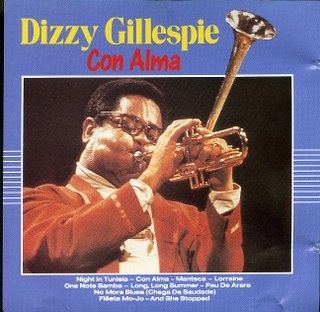
I was wrong on all counts. I woke up my friend alto saxophonist Gavin Walker today and we did some research on what he calls minutiae. The clincher was the 9 minute 25 second duration of Con Alma. He identified the sax player as Sonny Stitt and the piano player as Ray Bryant. Drummer Charlie Persip is perhaps the one with the maracas.
Before Gavin rang off he said, "Make sure you tell Rebecca that she has good taste." I would not want to confirm Walker's statement as that would mean that I have good taste, too! But Rebecca and I seem to agree. We both love listening to the many versions of Gerrry Mulligan playing My Funny Valentine. I will have to introduce her soon to that classic Brubeck composition The Duke (in honour of Duke Ellington)or my different versions of I Didn't Know What Time It Was particularly the one with Lester Young. And then there is Charlie Haden's (Quartet West- In Angel City) First Song (For Ruth). But then there is the Stan Getz (with Kenny Barron on piano) interpretation of First Song (For Ruth)... Will I be able to get all this into Rebecca before we are cut off at the path by her emerging teenagehood?
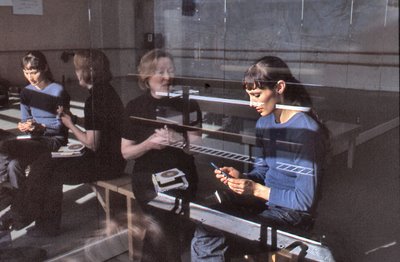
I have been on this tack before but I am so moved when I happen to notice it that I cannot resist.
On page 1 of Roland Barth's Camera Lucida he observes:
One day, quite some time ago, I happened on a photograph of Napoleon's younger brother, Jerome taken in 1852. And I realized then, with an amazement I have not been able to lessen since: "I am looking at eyes that looked at the Emperor." Sometimes I would mention this amazement, but since no one seemed to share it, nor even understand it (life consists of these little touches of solitude), I forgot about it. My interest in Photography took a more cultural turn.
On the other Monday Lauren and I attended a rehearsal of Dancer's Dancing. In spite of the opportunity to watch a work in progress and get a glimpse into the mind of a choreographer there were no more than 10 in the audience including Ballet BC dancer (not dancing these days because of a bad hip injury) and choreographer Simone Orlando. It was all very pleasant but I was saving my excitement for Desirée Dunbar's solo performance. I was not disappointed.
Dunbar was wearing a long purple dress/skirt/cover that she swirled so that you could see her beautiful and muscular legs. And she swung around a large collection of purses (I will not explain except to say that when Lauren looked at all the purses on the floor, before the performance, and questioned me, I just said, "Perhaps she is going shopping.") I chatted with Dunbar after and found out she is from Lillooet. I told her about my daughter who teaches there. But I found the time to ask her, "The swirling skirt - does that have anything to do with Judith's (Judith Garay) former mentor (Martha Graham)?" Dunbar answered, "Yes."
It is no accident that the most famous photograph of Martha Graham (and one of the most famous photographs of dance) taken by Barbara Morgan features Martha Graham in a swirling dress.
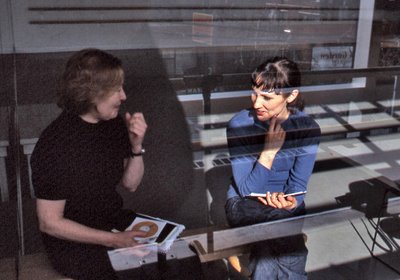
As I left and spied Judith Garay and Simone Orlando chatting I wondered if soon, Orlando might not choreograph something that has swirling dresses. I would bet on it.
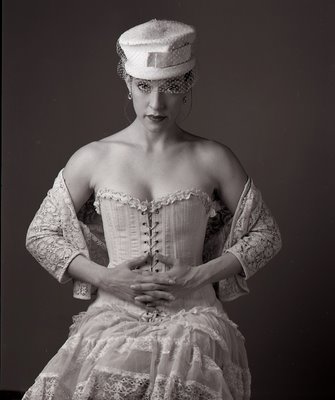
I find it amazing that the apparent demise of photography is greatly exagerated. I have eager students at Focal Point who pay good money to listen to me talk about the problem with contrast in photography (most ignore it to their peril) or my constant criticism on the appearance of those terrible neck folds in their portraits or nude studies. Here are some pictures of Marthe in 1998. They are full of neck folds and, even worse, bad crops of legs and other extremeties. It would seem that what I now teach I have only learned most recently. But at the same time there is a quality that I can discern in these pictures that has all to do with my experimentation of different posing and shooting techniques on a seasoned dancer with flexibility, strength and a womanly presence in spades.
Yesterday I visited Horst Wenzel who tightened some screws on the cocking lever of my Mamiya RB-67. He asked me if I was still taking nudes. He also asked me why I do this. I explained as I explain to all my classes that the photography of nudes is a great help in the posing of the clothed. In my nude sessions in the studio there is no particular goal in my mind. I am not to take a head shot, or a profile that is to bleed on a page.
Or it is not a picture that will appear on a magazine cover and I have to watch for room on the bottom left to allow for a bar code. With inside magazine covers I have to be conscious that if it is a two-page spread the magazine gutter might split my subject's face. Of late I have chosen in my fun/experimental shoots to use faster film with no flash. I have been finally taking advantage of my big studio windows.
I have written about other reasons for the photography of the female body here.
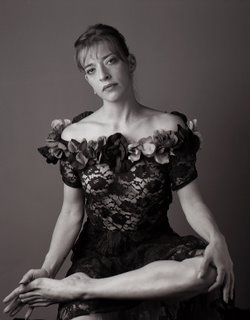
With Marthe I had the obsession (one that is yet to diminish) of capturing that aspect of classical dancers and modern dancers that has nothing to do with grace, ease of movement or the ethereal presence of a swan. I wanted to and still want to reveal their woman aspect.
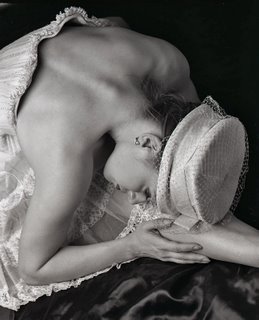
Today in the afternoon I will have the tall and strikingly beautiful modern dancer Delia Brett in my studio. She is going to appear with her 7-year-old son Beckett. Beckett looks exactly like his mother. I have never ever spoken to Miss Brett but I have seen her in performance. I only wonder why nobody has yet to assign me to photograph her. So I approached her. For those who are not familiar with the portrait photography of the German August Sander, it was this man whom I most admire for his quality of capturing a person's essence in particular to the person's profession. Sander captured for all time the essence of the young German soldier. This was an essence that lied nonetheless. But his portraits of bakers, policemen, Jews (those taken in 1938 are poignant as you know that perhaps a year later they would be dead) and the town beggar ooze with honesty and a respect for who they are.
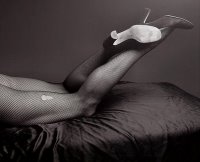
Today I want to extract an August Sander type of picture that could be labeled "Dancer & Son". I have no other plans, no predisposed ideas and lots of excitement.
The warning message arrived on Monday, the bomb itself on Wednesday. It became a busy week.
The Care of Time, 1981, Eric Ambler

Last Tuesday I went to Focal Point to teach my perennial class The Contemporary Portrait Nude. I decided to take the B-Line bus which drops me off half a block from the school on 10th Avenue. The stop is right by a used books store. I always look in the window. I immediately noticed the Eric Ambler novel (sometimes called political thrillers), The Care of Time. I knew I was going to buy it for two reasons. I read any book by the English author who died in 1998 because he was my mother's favourite thriller writer. I may have been 15 when she handed me a copy of his A Coffin For Dimitrios. I re read it every few years it is that good. It begins:
A Frenchman named Chamfort, who should have known better, once said that chance was a nickname for Providence.

A Coffin for Dimitrios paved the way for my later appreciation of Ian Fleming, Len Deighton, John Le Carré and Graham Greene (in particular The Confidential Agent). The second and most important reason is that here was a novel by Ambler that I had not read. I opened the book and read the first incredible paragraph (above). I paid $4 for a first edition which is in reasonable shape. The photograph (seen here) of the author by photographer Stephen Cornwell graces the back cover.

This novel, about a ghost writer who has a good reason to dislike both the CIA and the Iraquis, has a relevance today. Consider the second paragraph:
The message came in an ordinary business envelope that had been mailed from New York but had no return address on it. Inside, folded in three, was one of those outsize picture postcards that are offered to tourists in some places nowadays. This one was of a hotel with palm trees and carried an ornate caption proclaiming that it was the Hotel Mansour, Baghdad, Republic of Iraq.
Yesterday afternoon I visited my friend, photographer Raymond Lum. As a graduate from LA's Art Center he is very much like all the other graduates of Art Center that I have met. This means that Ray is most concerned with accuracy and perfection. With the advent of digital photography the pictures on his monitor have no hint of colours that were not in the original scene that he saw before he photographed it. His portraits have neutral gray backgrounds, blue shirts are blue with no hint of purple and skin tones are real enough to almost be uncanny.
Ray made an uncharacteristic mistake when he told me, "The difference between shooting RAW and a jpg (two different methods of storing the information of a digital photograph) is that RAW images have richer colour." As I admired Ray's realistic portrait of a real estate agent (Plato might have called it an essence of the real estate agent) I answered back, "Ray, I like your portrait because it is accurate. I am not interested in richer colour. I am interested in accuracy." One of the reasons Ray gets this accuracy is that he does not depend on a DSLR (digital single lens reflex) but has a scanning back attached to his Hasselblad. The pristine image of the real estate agent is a whopping 20 megabytes.
Looking at Ray's accurate portraits (he spends a considerable amount of money and much effort in making sure his top-of-the-line LED monitor is calibrated to his specifications at least once a month. Any picture that you see on his screen and one that he prints on his inkjet printer are virtually identical), I thought of the Acoustic Research ads of the early 60s that advertised a unique approach to sound. AR conducted a series of over 75 live vs. recorded demonstrations throughout the U.S. in which the sound of a live string quartet (The Fine Arts Quartet) was alternated with echo-free recorded music played through a pair of AR-3s. In this “ultimate” subjective test of audio quality, the listeners were largely unable to detect the switchovers from live to recorded, a strong testament to Acoustic Research audio quality. This was in an era before we began to boost bass, zing the higher frequencies and surround ourselves with sound or hear it inside our head from a little machine in our front pocket. A sense of loss in the original quality of sound has many an iPod owner docking the device into a tube amplifier that is supposed to uncompress the sound and return the original presence taken out during compression.
By the 80s, sound enhancement concepts had wandered off into the realm of photography. Film was made with punchy colours and increased contrast. There was slide film that gave people an artificial sun tan. It was advertised as having a warmer and rich colour. I had an admiration for the colour carbro process nude prints by Paul Outerbridge taken in the late 30s and 40s. Skin looked real. Instead of this accuracy we were fed high contrast and gloss by Cybachrome technology.
From his first 1936 novel The Dark Frontier to his 1991 Waiting for Orders Ambler wrote cool thrillers in which most of his protagonists were ordinary (in some cases colourless) people who more often than not accidentally got involved in situations that were completely beyond their control. One such man is Charles Latimer a lecturer in political economy who writes his first detective novel at age 35, called A Bloody Shovel. Latimer is the main protagonist of A Coffin for Dimitrios whose life changes when he meets (in Istanbul, naturally!) one of the most interesting and complex characters in thriller writing, Colonel Haki. The suave Colonel tells Latimer:
"I get all the latest romans policiers sent to me from Paris," he went on. "I read nothing but romans policiers. I would like you to see my collection. Especially I like the English and American ones. Al the best of them are translated into French. French writers themselves, I do not find sympathetic. French culture is not such as can produce a roman policier of the first order. I have just added your Une Pelle Ensanglantée to my library. Formidable! But I cannot quite understand the significance of the title." Latimer spent some time trying to explain in French the meaning of "to call a spade a bloody shovel" and to translate the play on words which had given (to those readers with suitable minds) the essential clue to the murderer's identity in the very title.
Much has been written on the excellence and richness of Patrick O'Brian's nautical novels. I, too have found them excellent and I have read the series twice. But this does not mean that I will forgo the enjoyment of C.S. Forrester's Hornblower novels. I find a telling connection between Forrester's Hornblower and Ambler's everyday men who rise to become heroes. I see a further link between Acoustic Research's (and Angel Records) penchant for accuracy and Raymond Lum's near obsession with the accuracy and neutrality of colour in his photographs.
It is almost impossible to understand what is in Hornblower's mind at any time because Forrester choses not to tell us. He does not colour or enrich the man with deep thought. It is there, but between the lines. The reader has to extract it. It is for this reason that Gregory Peck's performance as Hornblower is so perfect. We have to imagine everything in a glance or a pressing of lips. Ambler's description of Colonel Haki seems to be matter of fact but beneath it all is a man who is complex and scary. And much the scarier as we weigh him in our imagination.
I tell my students at Focal Point that unlike film photographers (as this one) they now have the power to record and display the colour and subtlety of human skin with a near perfection that was never there until now. So few of them take advantage or understand the gift they have.
Thankfully there are a few out there (Raymond Lum is one of them) who like Ambler, Forrester, and my Acoustic Research amplifier provide me with the richness (pardon me!) and the enjoyment of that which is plain and accurate.
The man standing in the shadow of the doorway turned up the collar of his overcoat and stamped his numb feet gently on the damp stones.
First paragraph, Cause For Alarm, 1945, Eric Ambler
Román Lopez Forment - Dusenbergs - Moritz Moszkowsky & Wee Willie Winkie
Monday, April 28, 2008
‘You’re a hero, Winkie,’ said Coppy—‘a pukka hero!’
‘I don’t know what vat means,’ said Wee Willie Winkie, ‘but you mustn’t call me Winkie any no more. I’m Percival Will’am Will’ams.’
And in this manner did Wee Willie Winkie enter into his manhood.
Wee Willy Winkie - And Officer and a Gentleman
Rudyard Kipling

In the late 50s and early 60s Román Lopez Forment was a weekly guest for dinner at our home ( I lived with my mother and grandmother in Mexico City). Román's mother, Josefina, was my grandmother's sister. She had been widowed in the Philippines so she moved to California with her daughter and five sons. It was there that her sons were adopted by a mafia don.
Román, who as a young boy had had unruly curly hair that made him resemble a Polish pianist and composer, Moritz Moszkowsky was given the nickname Moszkowsky and was a favourite of my grandmother. He quickly became one of my favourite uncles because of his stories of life in California in the 1930s. He and his brothers had money (the mafia don?) so they drove Dusenbergs, Auburns and owned yachts. They wore white slacks, played tennis and did not work much. There were many women. Román scandalized his family by marrying his manicurist who was a Mexican born German. Bertha and Román moved to Mexico. I was never smart or curious enough to find out what happened at the end of prohibition if that is were the Forments lost their regal family fortune. Bertha and Roman had two daughters and three sons and lived in the working class neighbourhood of Tacubaya. It was in Tacubaya where in the American British Cawdry Hospital both my daughters, Ale and Hilary were born. I remember vividly visiting them one day. A relative of Bertha's had appeared driving a Taunus. Bertha proudly told me that it was a German Ford.
When I was 14 Román's brother Vincent sent his son Bryan to stay with us. Bryan developed a terrible toothache. My mother sent him to the dentist. It was a terrible abcessed tooth which the dentist removed. We never heard the end of it as Bryan's father was a Christian Scientist. He told my mother that we should have obtained his permission if Bryan was to see a doctor. I remember this all very well because it was during those days that I had gone to see Grace Kelly's (the love of my life at that moment) last film, The Swan with Lois Jourdan and Alec Guiness (who played the prince who in the film accomplishes what Prince Rainier did in real life, take Kelly away from us!). I had gorged myself on a huge bag of pistachios and was so sick I did not eat a pistachio until last year. Bryan laughed when I mentioned that I loved Grace Kelly's neck. Bryan was more sexually precocious than I was and he suspected (rightly) that I did not know the meaning of the verb form, to neck.
Years later in 1967 I visited Vincent (my uncle Vincent who lived in Milbrae, California. Bryan was in college. Of the visit I remember nothing but I do remember visiting Vincent's brother Ralph who lived and lives in Stockton. He invited me for a barbecue in his backyard. As he was pouring soy sauce on the meat ( I had never experienced the custom of putting anything on cooking meet except salt, after all I am Argentine) I was astounded to see an ocenan liner parade past on the other side of my Uncle Roman's hedge. While I had recently attended a performance of Jefferson Airplane and I had marvelled, during the performance, at the sight of a pretty young girl in a corner staring at the greenness of her tiny glass of Crème de Menthe for what seemed hours, I could not believe my eyes. It was then that Uncle Ralph explained that Stockton was a sea port because of the ship channel and that the channel in question was in his back yard.
It is only now that I am 65 that I am curious enough to want to know who the mafia don was. Where did the money come from? Where did it go to? I had my chance a couple of years ago when cousin Bryan Forment and wife (out of the blue) visited me from San Francisco. He explained how his grandfather had had constant visitors who would kneel in the presence of his grandfather. I never asked. Bryan died last year.
His daughter Page and her husband Charlie Berghoffer (they live in Redmond, Washington) visited today. They don't know the story. I wonder if I will ever know.

Page and Charlie asked me if I was going to add (handwritten by my mother) to my mother's fold out family tree where I showed them how I was related to the Forments. Looking at their young and enthusiastic faces I probably brought them down by telling them that nobody in a few years would care and our decendants would then create their new family trees and we would be in a distant but forgotten past.
I was lucky enough to have an Uncle Román who visited and filled my head with wonderful stories. Could such wonderful stories entertain Rebecca? Can stories be stories if they have no special effects? I suspect it is yes. Lauren and Rebecca had a sleepover with us last night. I had to pick a movie we could all watch. I went to Videomatica with the idea of selecting the 1971 version of Kidnapped with Michael Caine. But I returned with John Ford's splendid Wee Willie Winkie with Shirley Temple, Victor McLaglen and C Aubrey Smith. But it was Cesar Romero's Khoda Khan, the rebellious revolutionary from Northern India that made Rebecca remark, "He is very good looking." This he was and we all (including Lauren) enjoyed a film in which Kipling's original protagonist Percival William Williams somehow becomes an extremely cute Priscilla Williams (Shirley Temple). Kidnapped may have to wait as more Shirley Temple will perhaps be in order.
Lurid Rhododendrons & Watermelon
Sunday, April 27, 2008

Yesterday I wrote about the epimedium and how I call it the Cinderalla of the garden. It's not there until you notice it. A plant, that is quite the opposite, owu with a flower that screams at you is the rhododendron. There are over 1000 species in this genus. There is an incredible variety ranging from whites and pale pinks and off whites to the most lurid oranges, reds, shocking pinks and purples. It is unfortunate that in Vancouver during the 50 and the 60s the most popular rhododendrons were plants that were bred for colour without any consideration of scent (there are some sweetly scented rhododendrons). These hybrids are pretty well indistructible, mostly disease free and faithfully bloom just about now. There are several in my garden and when we bought our house back in 1986 we could have gotten rid of them. I simply can never get rid of a plant unless it dies. And now when I have come to find them unsightly it is much too late. If I take them out it would take years for species rhododendrons to bulk up to size. Rosemary and I will have to ignore the "loud" screams from these plants.
Rebecca appreciates and loves rhododendrons. I have taught her to pass her fingers under the plants in the rhododendron walk in VanDusen. Many have an underside hairy substance under the leaves called indumentum. The colour can be white, pale white and many times a rich cinnamon brown. This indumentum can be very soft and it feels like the inside of a cat's ear. In our garden we do have Rhododendron luteum formerly Azalea luteum until botanists upgraded them to rhodos. Rebecca knows that when this rhododendrum blooms in about two weeks the yellow flowers will be extremely scented and when they beging to decay they paradoxically smell more strongly and more sweetly.
The mature hybrid rhododendrons in our garden are here to stay. Perhaps I respect the taste of Mrs Young who lived in our house for many years. Perhaps there were few species rhododendrons being sold and she only bought was was in the market.
Rebecca and I will simply have to visit that other garden of ours, VanDusen Botanical Garden and enjoy all those hairy leaves and sweet scents. They are our plants, too.

And when Rebecca and I want to smell Rhododendron decorum whose white flowers smell like ripe watermelon we can always visit our friend, gardener Pamela Frost who has a couple in her garden which she planted from seed. As the buds open they go through many colours before they finally become white.
Epimedium x rubrum - A Cinderellla Plant
Saturday, April 26, 2008

Our garden is a May to end of August garden. This is because that's when the roses bloom and hostas flower in June/July. There are some gardeners who want a 12-month garden. The work that entailes is really beyond the capability of two of us. Besides we want to rest from the garden and we are sure the garden wants to rest from us. As the garden decays in late fall I even enjoy the decay and the falling leaves. There is beauty in death.
We are about to enter May and that is when the fresh shoots of my hosta emerge in their pristine green or light yellow. They are wonderful, and as wonderful as the unfurling ferns.

But there are some plants which I call the Cinderella plants. Nobody notices them. This is because they bloom quietly about now when I am not looking for flowers. One of the Cinderella plants is the Epimedium. This Epimedium, Epimedium x rubrum caught my eye today. It blooms before the new leaves are out. In a few weeks when the leaves emerge the flowers will be invisible, covered by the hostas and the ferns. The flowers are no bigger than the nail of my smallest finger. They look like little stars or little space fighters in a science fiction film. Perhaps epimedium has been damned by being considered a ground cover. Can any other name condemn such a plant? Perhaps I will notice it a bit more from now on.
Kelly Tough - Not So
Friday, April 25, 2008

In the mid 80s Vancouver had a reputation for beautiful women who had been discovered and then posed for Playboy Magazine. In 1983 Vancouver Magazine decided to do a story on four of them. I was assigned to photograph them and Les Wiseman wrote the story. They eidtor and art director felt that if the local photographer and Playboy talent scout Ken Honey photographed them the material would be too racy for a city magazine.
I had watched Ken Honey in action at Wreck Beach. To be fair he was nude too while he walked around with his camera. His favourite mode of operation was to approach large breasted women who owned dogs. He would pet the dog and start a conversation. While he did this he checked for droop. I talked to a few who had told me, "Ken chatted with me but then he suddenly went away. I knew it had to do with the droop of my breasts!"

Of all the Playboy Playmates I got to meet and photograph for the article (some refused to be photographed) the most interesting was Kelly Tough. She was friendly and really seemed like the girl next door until you noticed her chest. I took photographs of her at home and used her flowery wallpaper as a background. The art director, Rick Staehling sent me back for a re-shoot. It seems my pictures weren't glamourous enough. I don't recall what he said to me but it was something like, "You have some good material do work from. I am sure you can do better."

At the time I used umbrellas instead of soft boxes. I really had no clue how to shoot glamour and I made the mistake of positioning my umbrellas a bit too far so that the lighting was a bit flat. But my flat lighting made the playmates' complexion look extra smooth in that pre Photoshop era. We didn't really have to resort to air brushing.

Looking back at those 1983 photographs I see in them an innocence of an age and my own. I remember asking Les Wiseman (certainly more worldly than this Catholic educated photographer) about pornography here. I remember looking at Kelly Tough strangely but she quickly set me straight. She was kind and easygoing and most cooperative in spite of this stumbling photographer.

She looked at my Polaroids (left) and gave me constructive criticism. She made me relax. I became a fan and felt most jealous when a legion of photographers snapped her picture at the PNE!

Self-Portrait In Burnaby
Thursday, April 24, 2008

I first met Yuliya at Focal Point a few years ago. She was the model in one of my classes. She has been our favourite model since because unlike other models she shows up on time and never fails to appear. I have written here before about the relationship between a photographer and a model. I have a similar longish photographic relationship with Yuliya (she is from Ukraine, and is visibly annoyed if you happen to say, "the Ukraine"). She shows up at my studio every 6 months and we shoot for fun. But it isn't too much fun as she is demanding, critical and doesn't like any of the pictures I take of her. I wonder why she keeps coming back for more?
But she did like the combined self-portrait you see here. I have taken some before and of them Yuliya has said, "You were nervous and stressed out in my proximity and the picture is no good." How is one supposed to feel in the presence of a beautiful woman who is not wearing anything, particularly when I know that one of the most sacrosant of my shooting rules is that I never touch? She insisted on this last one and posed me for it. It was at her Burnaby basement suite and she had a curvy mirror on the wall.
She did not like any of the pictures that I took that day a few months ago but of this self-portrait she said, "It is perfect."
Claudette Colbert, Don Ameche - A Classy Cinderella Revisited
Wednesday, April 23, 2008

Yesterday Rosemary and I sat down to watch Mitchell Leisen's 1939 film Midnight (it first opened at the Paramount on Broadway in April 1939).
While Rosemary set up our clandestine TV trays I boiled gnocchi and mixed it with green peas, chopped raw onion, butter and Maldon Kerala pepper. On this I sprinkled just grated Parmesan cheese and crumbled three pieces of thick bacon. We sat down for what I knew was going to be an extremely pleasant experience. Can you imagine a film with Don Ameche, Claudette Colbert, John Barrymore (who played the fairy godmother) and Mary Astor (her usual devious self)? And consider that one of the script writers was Billy Wilder.
This film had all the class and comic touches of another director of the period, Ernst Lubitsch whose 1939 Ninotchka, with Greta Garbo and Melvyn Douglas is another favourite of mine. I despair that if I watched this with Rebecca she might not understand the communist commissar aspect of it and not appreciate how Garbo breaks down and softens up. Does a 10-year-old know about the Soviet Union, communism and the bourgeoisie?
It is perhaps an obsession of mine that when I watch a film I always wonder if it would be one that Rebecca would enjoy and appreciate. With so many "crass" remakes of Cinderella in a modern world urban setting this one, Midnight, is set in Paris and the Ritz (populated by people who played bridge, drank Champagne and had no visible means of earning an income)and with a dashing prince (Don Ameche) who is a hungarian cab driver just might teach Rebecca what class is. And I will have to introduce her slowly to the real reason why Midnight is such a hit. Claudette Colbert plays an American small town gold digger who wears satin with panache and oozes the experience of woman who has seen the world, known her men and how they affect her and become all the wiser.
And how can I teach Rebecca to appreciate films in which:
1. There are no special effects.
2. There are no real villains.
3. Nobody is shot, killed, maimed or blown up.
4. And, principally, that the fairy story ending is far more believable than the special effects of contemporary films.
I was unable to explain to Rebecca last Saturday that going to Ballet BC's Peter Pan was a special occasion that warranted getting dressed up. Her parents did not seem to understand either. I explained to Rebecca that many of the girls who had dressed up rarely went to the ballet. The ballet is expensive and we just happen to have friends in higher places and thanks to photographic trades I am able to go to these events more frequently. Dressing up for the ballet is like drinking Coke from a Champagne glass. It tastes better.
Watching Claudette Colbert and Don Ameche spar in a taxi (with wonderful headlights esconced inside the grille. What car was it?) is very much like drinking that Coke in a Champagne glass. It is so much better than anything that is attempted now.
The original film review in the NY Times by Frank S. Nugent can be found here. It is my hope that this lovely review will open to all of you who might try. The review itself has that class, that dressup class that has all but disappeared.
The Perceived Paleness Of It All
Tuesday, April 22, 2008

For some time I have had the suspicion that all was not well with the appearance of this blog. Since I am stubborn, I dismissed the fact that my pictures always looked pale on someone else's monitor simply as the result of improper monitor calibration on their part. I insisted, to those few who pointed it out the paleness, that my monitor was properly calibrated and the pictures of my blog looked just right.
But I should have suspected from the beginning that my aging cathode ray tube monitor (a used Dell) could not really be properly calibrated.
For those who might be confused by the above let me give an explanation. When a photographer uses film, for better or for worse, the hard copy result (slide, colour negative or b+w negative) is an accurate record of what the photographer saw if the photographer strived for photographic accuracy. Transparency material (larger slides, and slides in general) tend to make shade blue. My Ektachrome has been rendering the gray background of my studio portraits to various shades of "Ektachrome blue". High saturation colour film makes greens (lawns for example) greener. In short colour film, even when properly exposed, is not accurate in the display of colour. One very important reason is that film (all kinds) have an extra sensitivity to ultraviolet light. Film and the human eye perceive light and colour differently.
Accurate or not, when I handed in a slide to a magazine art director, the slide served as a standard for the magazine printer to go by. The art director could have either cooled or warmed up that image for personal preference. Sometimes art directors will do that to balance the look of a two-page spread (as an example) where two pictures, one cool in colour and one warm might clash seen together on the page. Our perception of colour is subjective.
Photographs can be light or dark. Some are shot dark on purpose, perhaps for drama, or dark by mistake because of underexposure. The portrait of a baby might be rendered slightly lighter and in a pastel colour to convey the idea of innocence. In pornography the colour of "bits and pieces" might be darkened for effect. When I print my b+w negatives in my traditional darkroom I have perceived periods where I tend to make my prints dark and contrasty. These periods have alternated randomly with times when I have printed paler.
But always the slide or the photograph (colour or b+w) is the ultimate record and standard of the photographer who has taken it.
With the advent of the digital age all this has changed. The photographer who shoots with an expensive DSLR (digital sinle lens reflex camera) has no hard copy original. The original is a series of zeros and ones captured by a sensor and stored in the camera's memory. In a wonderful way this stored image, particularly when the photographer does not "cheat" and does not look at the image on the back of the camera right after an exposure (this practice of looking is called chimping) displays all the potential of that wonderful world that came into being with photography in the 19th century. This is the latent image. The image that is there in our imagination and in the unprocessed film stock (if we are lucky!). The image that we think we have captured but that has to be "developed out" or processed before we can see it. A roll of exposed b+w film (as an example) when held in your hand it is pure potential. It is the potential of latent images waiting to see the light of day.
When a digital camera photographer finally "opens up" the taken images the "original" is an infinitesimally thin image that sits on a monitor screen or on the LCD screen in the back of the camera. When the photographer (let's suppose the photographer is a magazine photographer) sends images to a magazine art director by email, the original image that can be used as a standard has to be (there is no other) the image sent. This image can vary if the photographer and the art director's monitors are not calibrated equally. And if the monitor used by the magazine printer is different, that will also stretch the problem of reproducing an original as the photographer saw it, or thinks he or she saw it, or as he or she thinks it should have been by introducing modifications with PhotoShop (in itself just a super flexible version of darkroom manimpulation).
The above is to explain that until yesterday most of the images of my blog have been too pale for most who have perused my blog. Last night I darkened a couple of week's blogs. It was labourious particularly in the multi picture blogs with 5 or 6 pictures. I have to remove and re-insert each one, one at a time.

For close to a year my monitor display has been the above picture of Rebecca and Lauren taken in the summer of 2006. For that year the picture looked just right on my monitor. This is what it would have looked to all of you had I inserted it into my blog.
Magnolia stellata - Stella Maris?
Monday, April 21, 2008

Magnolia stellata grows wild in certain parts of the Ise Bay area of central Honshū, Japan’s largest island, at elevations between 50m and 600m. It grows by streamsides and in moist, boggy areas.
Our Magnolia stellata (Star Magnolia) came from a nearby garden. The house was being torn down. I asked the crane operator if I could help myself. With a smile he nodded in the affirmative. The magnolia replaced a dead Lawson cypress by our kitchen bed that had died of root rot. Our garden when we purchased the house in 1986 had at least 8 of these cypresses that have succumbed to root rot. We have been replacing them as they die with other trees. The magnolia for me has been a tree of fascination because of its great botanical age. There are fossilized specimens of Magnolia accuminata that date back 20 million years. Magnolias were flourishing before bees so the flowers are designed to be pollinated by beetles.
Our stellata is in bloom right now and it has never looked better. The reason is that it has not rained. Rain makes the stellata blooms look like sickly droopy mess.
I associate our stellata with the name of an Argentine navy chapel in Buenos Aires called Stella Maris. It took a while before I figured out the name. Stella Maris (or Star of the Sea) was the name sailors gave the Virgin Mary. Of all the armed forces of Argentina, it is the navy that is the most Catholic. When Perón started burning churches in 1955 the Argentine Navy began the rebellion that ultimately toppled the dictator.
Edmond Kilpatrick - The Man Who Loved Women
Sunday, April 20, 2008
Yesterday Rebecca, Lauren, Rosemary and I saw Edmond Kilpatrick's last dance performance, as Captain Hook in Ballet BC's Peter Pan. He is leaving Ballet BC.

It seems that since I first started taking photographs of Ballet BC dancer Emdond Kilpatrick back in 2000 he always posed for me with a woman. Paradoxically it was when I took his picture in my studio with dancer Connor Gnam (then with Arts Umbrella) that I realized his ease in fitting in not only with ballerinas but with male dancers, too.

It was Kilpatrick who started in Vancouver a program to entice young boys into ballet and dance while at the same time showing them the respect that a male dancer deserves in this day and age. And it was watching Kilpatrick teach a class at Arts Umbrella (my Rebecca was in that class) that I noted his blend of gentleness (he never raised his voice) and his absolute demand for perfection. Rebecca complained he was too demanding. I smiled when she said this as I know that if a 9 or 10 year-old is not pushed she will do nothing and just get by.

In the 8 years that I have observed Kilpatrick I noted that he was one of the few (besides Jones Henry) who was able to pick up the almost as tall Emily Molnar. It was Kilpatrick that enabled Alleyne to choreograph for that stupendous dancer that Molnar is. At first I was turned off by Kilpatrick coolness. His dance seemed to lack passion. But then I noted how this coolness made the women react with passion as they danced with him. His Don José in Alleyne's Carmen was just right to Sandrine Cassini's Carmen (third photograph from top). When he eventually sticks the knife into her it was believeable. The cool man had snapped. When I photographed Kilpatrick with Cassini and Acacia Schachte for Carmina Burana it was Rebecca, who was present at the shoot, who noted to me the attraction that women had for him.

If anything Kilpatrick has represented to me the cool jazz performer who smoulders on the inside. This coolness has not prevented me from finally realizing that part of it is due to a shyness that he has somewhat not shed yet. Yet when he does smile (something that seems to not do often) it is an easy and warm smile.

I remember that when Kilpatrick emerged on to the dance scene in the late 80s every female publicist, every female dance critic or arts writer/editor fell for his charms even to the point of swooning is his presence! I know because many of them confessed this to me. So when I had my first chance to photograph Kilpatrick for the Georgia Straight, I asked him to bring his Russian ballerina wife Victoria(the first two photographs above) to our studio session. I am sure that many women will miss the strong, tall and cool presence of Edmond Kilpatrick in Ballet BC. I can add that this man will miss him, too.

Ballet BC's Peter Pan, John Alleyne's Right Hook

Of late, trying to take Rebecca to dance, to concerts or to theatre has been a hard sell. With slight encouragement from home and the stressing that I am a tad too agressive on taking her to cultural events she has rebelled. To show her rebellion she chewed bubble gum and blew bubbles during Michale Jarvis's exquisite harpsichord solo in Bach's Brandenburg Concerto No 5 some weeks back.
The only reason Rebecca came along with Rosemary and Lauren to yesterday's matinee performance of Ballet BC's Peter Pan (choreographed by Septime Webre) was that her mother insisted on it. We attended the pre-ballet talk and Rebecca was the only person to ask a question. I was proud of her poise and unshyness.
A few weeks back I might have muttered (perhaps Rebecca is right and I am on my high cultural horse) on how could John Alleyne offer Peter Pan when the Alberta Ballet was working on a second ballet involving Joni Mitchell. I read in the New York Times how the Kirov was featuring ballets by the noted American choreographer William Forsythe. Why Ballet BC had performed various Forsythe ballets before the Kirov knew who the man was.
Now I can see Alleyne's wisdom. At least from the point of view of not only delighting Rosemary and Lauren (and this recalcitrant high culture guy) but Rebecca, too. Rebecca insisted on spending $10 (a bribe from Rosemary for her reading and finishing two books last week) and buying a stuffed ballet bunny ("So that I can remember that I came with you to see Peter Pan."
We had a delightful time, we laughed at the ticking crocodile and laughed even more when the crocodile (Peter Smida) danced a Hollywood style tango with Captain Hook played by Edmond Kilpatrick.
Thanks to John Alleyne and Ballet BC I have been given enough cultural amunition to fight another day!
The Jeweler's Feet
Saturday, April 19, 2008

I have written about feet here, here and here. And Max Wyman wrote about feet here.
I will still not admit that I find feet in any way attractive. It all happened some years ago when a very pleasant female photographer told me, "Why don't you photograph feet?"

Immediately, I replied that I found feet the ugliest part of the body and that I also did not want to fragment the human body into body parts. I remember sharing a photographic shoow with another photographer some years ago. Both of us had nudes on the wall. In those years of femenist awareness I will never forget the woman who left a statement in the gallery guest book, "Waterhouse-Hayward, thank you for showing us the faces." Since then I have tried not to depersonalize the human form by stressing the parts.

At Focal Point I teach a somwhat popular class that I have purposely called The Contemporary Portrait Nude. I tell my students that even when they are taking pictures of our model's hands or feet they must not lose sight of the model's humanity and individuality. I stress calling the model the subject as the latter word does not include the idea of models with all our prejudices that we may direct at the meaning of that word.

And so against my inner desires to not photograph feet I have done so for some years. My favourite place has been Lynn Canyon in North Vancouver. The rushing cold water seems to add excitement. Some of the best and most erotic pictures I have ever taken were of the jewelry designer Susan Fiedler.


Susan Fiedler - A Face
Patrice B - Revisited - Rediscovered- Savoured
Friday, April 18, 2008

I have been thinking about beautiful women recently. More so today after having seen with Rosemary, White Cargo yesterday. White Cargo (1942) stars Walter Pidgeon, at his best, and Hedy Lamarr at her most beautiful. I have been thinking about beautiful women because in my two previous blogs on them I hardly ever knew them as they faced my camera. With Patrice B it was different.

I hinted a bit about her here. Looking at here files again today some of the bits and pieces that I remember about the session with Patrice have come back. I don't remember why exactly she chose to bandage her hands. "I want to feel like a boxer," she said. But I do remember that she was having to make decisions about her life.

One of them involved moving to the United States the other one had to do with either dumping her boyfriend or being dumped. While she asked me to photograph her nude she also indicated I take other pictures. In some I used my flash but in many the mottled lighting that was coming in through the windows was the single light. Looking back I can only now see the pattern.

There is a man's coat, trousers, sweater and socks. In some of the pictures she would smell intensely the sleeve of the sweater. While I cannot show some of the best nudes I have ever taken in my life here I can give a hint at the incredible gift of being able to observe a woman's itimate thoughts displayed through gestures, clothing and lack of it.


As I photographed Patrice I never thought that she had any resemblance to Cybill Shepherd. Now as I look at these photos I would say to the contrary. Shepherd looks like Patrice but is not as beautiful as Patrice.


It Has Been Done Before - Batesonian Wisdom
Thursday, April 17, 2008

My friend Ian Bateson used to drive me crazy when I would show him what I thought was an original and well taken photograph that I had taken recently. Invariably he would look at it and say, "It's been done before." He had me frustrated for years until one day I saw the light. I showed him a photograph and he said the predictable. This time I countered with, "But I have not done it yet!" I may have shouted this at him I was so excited at finally arriving at this piece of photographic wisdom. Since then Bateson has become a most supportive fan of my photography. I hope he understands how instrumental he was in my progress.

At least a decade ago I had two successful gallery shows. One featured a woman, Lisa Montonen holding different hosta leaves from my garden. I took them all in one afternoon in my studio and used only one light. The other show were portraits of women in tubs, all taken from the same angle and revealing nothing that would offend anybody. The lighting was much more complex but I knew what I was doing, or at the very least I knew what I wanted.

The testing, with all its mistakes of lighting, shooting angles and lack of direction, I imposed on brave women who posed for me in previous years to those shows. They knew I was experimenting with lighting schemes and approaches and patiently posed while I blundered. One of the most patient and one of the most calmingly beautiful was the late María de Lurdes Behar. Here you see my early examples of shooting a woman with a hosta leaf. But she did manage to be around to be part of my tub show. It was so charming to photograph a woman so tiny that she could easily bend into a fetal position in a very small tub.
The above is an explanation on how all photographers must go through a transition. They all must put their hand into the fire and feel the burn. Advice from others will never do. Photographers must experience it themselves. By their mistakes they will learn what not to do. When those mistakes become accidental successes the photographer, if methodical can track back to see how the mistake happened so that it can be repeated!
My photographs in yesterday's blog represent a transition in my approach to taking pictures of women. For my 21 first century tastes they look much too glamorous and devoid of substance. I would never photograph anybody in bed smoking. The romance of the woman smoking in bed is long gone. While the pictures of Vantana are not too revealing because if have pledged to keep my blog at a standard that it should not offend my granddaughter Rebecca (even though she has seen most of my nudes) or any of her friends. In one of the photographs posted yesterday I actually removed all traces of an "offending" nipple.
In order to photograph those pictures of Lisa Montonen with my hosta leaves I had to first experiment with the mottled lighting that I used on María de Lurdes Behar. It was too difficult to use. Depending on how the mottled lighting fell on her face it made her cheeks look big. Lisa Montonen had very blonde hair so I was able to separate her from my dark background without having to use a "glamorous" hair light.
Vantana's photographs were such a transition. They almost make me cringe when I look at them. But such was her beauty, her long legs, her high cheek bones, that my ineptness and innocence luckily did not carry the day.

Four years ago Rebecca, Rosemary and I went to Buenos Aires. I saw many ads of women in bikinis advertising everything from tootpaste to Fiats. The ads looked to this proper Canadian, obscene. I commented on it to my relatives. My rugby playing nephews thought I was insane and questioned my manhood. I tried to explain the concept of political correctness. I asked them exactly what the connection, between a beautiful woman in a bikini holding tootpaste, was with tooth decay. In the end I gave up.
Vantana Wears My Suit, Shirt & Braces
Wednesday, April 16, 2008

When I first met the tall Vantana some years ago, she reminded me a bit of Geena Davis. I proposed to her the idea of taking her picture in room 618 of Tony Ricci's Marble Arch Hotel. She agreed but warned me that she had recently cut off and bleached her wonderful hair. I wasn't going to wait for the hair to come back so we met at the Marble Arch.

For laughs I brought my dark blue pin stripe suit, a white shirt and braces. We took pictures in a room where I had photographed quite a few women before and a quite a few after. I was still experimenting with lights and no lights (some of these are long exposures with my camera on a tripod, using the light that was available in the room).

I followed my friend John Armstrong's idea that a lamp without a lampshade made pictures look a tad cheap and noirish. I have never used these pictures for anything but they certainly helped me progress in perfecting my style of photography.

I now use my light a lot closer and get more shadows. It is close in look to the one you see here where Vantana lifted the braces up to her shoulder. I was rendered speechless when I saw this.


A Rite Of Passage With No Help From Uriah Heep
Tuesday, April 15, 2008

There are several acknowledged rites of passage. The most important one (without which further rites become moot) is being born. My only proof of that event, now that both my parents are dead as well as others who might have attested to that event, is a tattered document that I had to translate on the spot for a kindly woman from Fiji (not so kindly and beaurocratic in her demeanor until I made her laugh with my chatting) at the Canada Government building on Quebec and 10th Avenue. I was there today to get a lesser known rite of passage, my Old Age Pension and my Canada Pension, that because I speak the language I was able to perform alone without company. There were quite a few elderly Chinese men accompanied by younger women, perhaps there to obtain the same service. This rite of passage is bound to be a unplanned harbinger of that final rite of passage in which we all leave unaccompanied, too.
Rosemary filled out the application forms and told me this sort of thing makes her very nervous. We have crossed too many borders in Latin America and Europe so her fear of application forms and government bureaucracy is not unfounded. Mine borders on the phobia.
As a child I never understood my mother's instructions when going to the Buenos Aires Police Department (part of the reason why I am afraid of going to government offices even now)to obtain some document, to affirm that my surname was Waterhouse-Hayward while hers was de Irureta Goyena. I was too young to understand the problem of Argentina not recognizing my father's divorce before he married my mother. I also had to memorize a different birthdate as my father had botched that and registered me almost a year after my birth.

The worse case was the scenario at the Mexico City airport sometime in 1956 when I flew in from school in Austin. The man at immigration said, "Young man it is impossible for you to be entering Mexico as I have no record that you ever left it." The mistake of a lazy official who had not stamped my leaving Mexico a few months earlier cost my mother many pesos in lawyer's fees and mordidas (bribes) to set the record straight. It also involved lineups at the notorious Gobernación on Bucareli Street where all residents of Mexico who were not citizens did their trámites ( a horrific Spanish word for official paperwork that includes the concept of long waits at lineups and being subjected to surly officials who think they are God. As a matter of fact there is a way of talking to these officials that necessitates the use of the subjunctive mood. It is a bureaucratic Spanish that makes Dickens's Uriah Heep seem even more odiuous when translated into the language of Cervantes.
"Should you in your kidness take my problem at hand, would there be a possibility that with God's help and your invaluable contribution to my affairs my application form might be seen by Mr. Perez before the end of the month? I would be eternally grateful to you and I would find a way of proving that. Perhaps I could help with a contribution for your forthcoming vacation trip to Acapulco with your dear family."
If the above did not help then one hired a coyote the deprecatory name given to men who would intercede (a go-between no less hated than a procurer) through connections to speed up paperwork.
My paper work at the Canada Government Office was a breeze. As soon as I told my Fiji born (of Punjabi heritage) official how my father had invited his friends from the Indian Embassy in Buenos Aires to a curry dinner cooked by him at home, she was mine. She had initially told me, most coldly, when she saw my documentation, "You wil have to have these registered for authenticity, etc." By the end of the interview (after I had told her in great detail a typical Argentine meal and how to cook it) she had stamped everything and told me, "Thank you for making me laugh."
Citizen Joe Kiethley
Monday, April 14, 2008

I remember the day that I spotted the once scary (only to me it seems) Joe Shithead outside my Burnaby home so many years ago. "Alex, we need you to photograph DOA for Interview Magazine," he said to me in his blasé way of saying things. Joe has always been straightforward about this sort of thing and indeed soon after I had a full glorious page in Interview Magazine with this picture. The other side of the page was a smaller picture (ha!) of the American punk band Black Flag.
As a photographer I am living in an age of chaos, less work, a decline in magazine work and the dumbing down of lighting so that everything looks like Flickr. The uncertainty of my profession just when I have received my Gold Card and perhaps a $200 government pension is stressful.
Yet, a week ago, last Sunday, there was Joe Kiethley and his band DOA in my studio. Joe had hired me to shoot the back cover photo for their upcoming CN Northern Avenger. What were the chances in our changing times and a music scene in turmoil that both Joe and I would be in my studio at the same time so many years later shooting for a CD? Whatever those chances might have been I am grateful to Joe and DOA for bringing a bit of calm to my unsettled life. How many people could say that about a punk band?
Thank you Joe for you perseverance, for not losing your way and specially for that evening of calm.
Beau Geste On Hold & A Surprising Moonlight Sonata
Sunday, April 13, 2008

There are those stories, the true ones and the ones that are not, of the-soon-to-be blind person who travels the world to see all. And there is the not quite historically correct concept of the barbarians at the walls of Rome. When they breach them the world slips into the middle ages and the lights of learning turn off with a few beacons being kept lit by Arabs scholars who translate the Greeks and the Romans into their language.
I think of all that as I gaze upon Rebecca and remember the film Charly. Cliff Robertson plays a man with a child-lie maind who is given a drug that makes him brilliant. But as the drug's effect begins to wane he now understands what it is that he is losing. He is losing something that he never had. And that is what makes this film one of the most tragic I have ever seen.
Perhaps I am over dramatizing this (I surely am!) in my quest to expose Rebecca to as much knowledge, situations, experiences before her teenage "middle ages" come crashing down. We can all see it coming. Last night she did not want to see Liszt's Rhapsody the film for children (and adults) from the series on composers. We have seen the ones on Handel, Bach, Beethoven and Bizet. Rebecca wanted to go home but only under the insistence of her mother, Hilary did we sit down to watch and Rebecca had no choice. As soon as the super handsome Geordir Johnson (who plays Farzn Liszt) appeared I watched Rebecca from the corner of my eye pick up the DVD case and read the credits. In the end we had a pleasant evening and we all learned something.
My daughter Hilary seems to have some sort of chip on her shoulder that I was not as insistent on the concept of culture and the educational when she was Rebecca's age. She is, of course, absolutely right. What could I have possibly known then? I may know just a bit more now but in our changing world I have come to the realization that knowledge of the esoteric (that which was not so just a few years ago) is a valuable commodity. My friend Abraham Rogatnick and others say I must go easy and not push. But the fact is that the change in Rebecca becomes obvious from one day to the next.
On Friday we attended a concert at St Jude's Catholic Church that was performed by Paul Luchkow, Michael Jarvis and friends. Rebecca insisted in not only chewing gum but blowing bubbles, too. Since we were only a few ft from violist Glenys Webster I could only wonder how it might have affected her playing (it didn't as far as I could ascertain). But I didn't say much. Rebecca had come to the concert and who knows how many more she will attend before the curtain of culture comes crashing down!
At the intermission I asked Glenys to chat with Rebecca. This she did and Rebecca also listened as Michael Jarvis explained to a little audience how his harpsichord worked.
Liszt's Rhapsody became a distant second choice to the film Rebecca really wanted to see Arctic Tale . At the very least Rebecca's original choice was educational. But this word is now a suspect word in our family. It represents something boring and tedious that I try to force Rebecca and Lauren to experience.
I think of the film Beau Geste where the only special effects is the problem of giving a dead legionaire a Viking funeral (complete with burning long boat and a dog at the dead man's feet) in the middle of the desert. The solution is an intellectual one. Intellectual special effects are now pennies in a Loonie currency. They do not hold their value.
So I live in a small fear that while I was under 10 when I first saw Beau Geste with my parents I might have to wait a bit longer to see it with Rebecca. It would break my heart if she soon grew bored. For years (she was past 20) her mother Hilary refused to see The Third Man because it was in ugly black and white.
But there was a glimmer of hope as I experienced a moment of paradoxical sadness mixed with joy. I was in the boulevard shoveling sand into my wheelbarrow when I heard Beethoven's Moonlight Sonata. I thought immediately of my mother who often played it and was hit by a wave of longing for her. But then I knew that somehow it was Rebecca playing it on the Chickering and that the living room window was open because of the warm day that yesterday was.
I told Rebecca of my sadness and joy and she immediately sat again at the piano and practiced for a lot longer than she would have on any other day.
Shannon Hums While Cleaning My Teeth & The Garden Will Be Done
Saturday, April 12, 2008

I have always disliked going to the dentist and to the barbershop, because invariably you become a captive audience to one who talks unceasingly. Half of that problem has been solved and I won't tell you which. Since the advent of no cavities (I guess I now brush my teeth regularly) quite a few years ago the issue of the talking dentist has been replaced by the problem of my dental hygenist, Shannon, who hums to all the soft rock that is piped into the room.
Yesterday,
All my troubles seemed so far away,...
But Shannon compensates with an excellent system of cleaning (scraping) my teeth. This is something I don't like but she makes it seem quicker because she uses a random approach. I don't have to think, "She's done the upper outside so now I have to suffer the... She scrapes here and there, has me all confused and before I know it she is through and the humming stops.
I was thinking about Shannon today as I worked in the garden. I moved a Mahonia from this bed to that bed. I put sand (to smother it) on moss in that bed. I fertilized the roses with liquid fertilizer. I pushed back the Choisya 'Aztec Pearl' so it will give room to Rhododendron schlippenbachii to grow. During all this work I realized I was not going at it methodically but using Shannon's method. Before I know it the garden will be "done".
For lunch today I made strawberry slush with strawberries, lemon juice, sugar and plenty of ice. Rebecca said, "Um, so good. I can't wait until summer so we can drink this in the garden.
Diane Farris, The Montgomery Café & Hovering Buzzards
Friday, April 11, 2008

In 1999, when photographer Fred Schiffer (one of the best portrait photographers Vancouver has ever had) died I attended his memorial service. I was near Olive Schiffer when the hovering "buzzard" pounced, "How would yo like to keep the memory of your husband's excellence alive? If you donate all his photographs to our archives that will happen." It was at that moment that I was hit by an internal fury and a determination that no buzzard shall alight on Rosemary should I make my earthly exit before she does.
A couple of weeks ago I received a call from gallery owner Diane Farris. She wanted to know who could help her obtain information about the Montgomery Café that used to be on Pender very close to the Niagara Hotel. While she was chatting with me I went down to my basement files (10 large metal filing cabinets with four drawers each) and under M I extracted my Montgomery Café file. Under F I removed the Diane Farris folder. I told Farris that John Mackie at the Vancouver Sun was her best bet and she rung off. But not before we mutually commented on the fact that I am exactly one day older than she is as I was born on August 31 while her birthday is on September 1.

My photograph of the Montgomery Café is nothing to rave about but it does show that the place was known for the art on the walls, the painted tables, the cow hide nooks and the excellent shakes. My picture of Farris I took in her original gallery on Water Street and the man behind her is her former husband.
It occurs to me that when I take my leave (as of now my files have 37 year's worth of stuff related to Vancouver) my files will be deemed valuable by many. It will be too late for me to be rich and famous. But I do have a little ace up my sleeve. I have made a will in which I stipulate to my wife and daughters that my photographic life's work:
1. Shall be sold.
2. Not donated to any archive.
And if 1 is not met the insructions are:
3. Burn.
From somewhere I know Fred is smiling and he approves. As for keeping my memory alive I will take the cue from my friend Abraham Rogatnick, "After me, nothing."
Con Alma
Thursday, April 10, 2008

My On Line RAE (Real Academia Española) dictionary of the Spanish language defines alma as:
alma
(Del lat. anĭma).
1. f. Principio que da forma y organiza el dinamismo vegetativo, sensitivo e intelectual de la vida.
Unlike soul (the equivalent in English) alma comes from the Latin anima so it has a slightly different flavour in both sound and meaning. Translating the above definition alma is defined as the principle that gives form and organizes the vegetative, sensitive and intelectual dynamism of life.
It is perhaps because of that askew meaning to alma with no side definitions associated with soul music (as an example) that I find Dizzy Gillespie's composition Con Alma so special. It is beautiful and the name, in Spanish, is icing on that cake.
When I take Rebecca to her ballet classes on Wednesdays I always insert a new CD with a track of my choice. She always wants to know what we are listening to. Her last "in-car-hit-parade" was Bach's Toccata in D minor for organ, ("That Dracula, piece,"in Rebecca's words). Her choice now is track 2 of Dizzy Gillespie Con Alma . This is a 9 minute 25 second version of Gillespie's classic.
The CD has no liner notes. No explanations are given and by the sound of the album I had nailed my Argentine countryman Lalo Schifrin on the piano. Rebecca thinks the song is lovely. I have a fondness for the constant maraca beat. At first Rebecca was confused when I told her Gillespie was playing the trumpet. She expected the open horn sound. In this tune Gillespie starts with a muted horn and only plays the open horn later on. The sax player (on tenor sax) is particulary good and I had guessed he was James Moody.

I was wrong on all counts. I woke up my friend alto saxophonist Gavin Walker today and we did some research on what he calls minutiae. The clincher was the 9 minute 25 second duration of Con Alma. He identified the sax player as Sonny Stitt and the piano player as Ray Bryant. Drummer Charlie Persip is perhaps the one with the maracas.
Before Gavin rang off he said, "Make sure you tell Rebecca that she has good taste." I would not want to confirm Walker's statement as that would mean that I have good taste, too! But Rebecca and I seem to agree. We both love listening to the many versions of Gerrry Mulligan playing My Funny Valentine. I will have to introduce her soon to that classic Brubeck composition The Duke (in honour of Duke Ellington)or my different versions of I Didn't Know What Time It Was particularly the one with Lester Young. And then there is Charlie Haden's (Quartet West- In Angel City) First Song (For Ruth). But then there is the Stan Getz (with Kenny Barron on piano) interpretation of First Song (For Ruth)... Will I be able to get all this into Rebecca before we are cut off at the path by her emerging teenagehood?
Swirling That Material - Martha Graham, Judith Garay, Simone Orlando
Wednesday, April 09, 2008

I have been on this tack before but I am so moved when I happen to notice it that I cannot resist.
On page 1 of Roland Barth's Camera Lucida he observes:
One day, quite some time ago, I happened on a photograph of Napoleon's younger brother, Jerome taken in 1852. And I realized then, with an amazement I have not been able to lessen since: "I am looking at eyes that looked at the Emperor." Sometimes I would mention this amazement, but since no one seemed to share it, nor even understand it (life consists of these little touches of solitude), I forgot about it. My interest in Photography took a more cultural turn.
On the other Monday Lauren and I attended a rehearsal of Dancer's Dancing. In spite of the opportunity to watch a work in progress and get a glimpse into the mind of a choreographer there were no more than 10 in the audience including Ballet BC dancer (not dancing these days because of a bad hip injury) and choreographer Simone Orlando. It was all very pleasant but I was saving my excitement for Desirée Dunbar's solo performance. I was not disappointed.
Dunbar was wearing a long purple dress/skirt/cover that she swirled so that you could see her beautiful and muscular legs. And she swung around a large collection of purses (I will not explain except to say that when Lauren looked at all the purses on the floor, before the performance, and questioned me, I just said, "Perhaps she is going shopping.") I chatted with Dunbar after and found out she is from Lillooet. I told her about my daughter who teaches there. But I found the time to ask her, "The swirling skirt - does that have anything to do with Judith's (Judith Garay) former mentor (Martha Graham)?" Dunbar answered, "Yes."
It is no accident that the most famous photograph of Martha Graham (and one of the most famous photographs of dance) taken by Barbara Morgan features Martha Graham in a swirling dress.

As I left and spied Judith Garay and Simone Orlando chatting I wondered if soon, Orlando might not choreograph something that has swirling dresses. I would bet on it.
D' Artagnan's Girl Revisited
Tuesday, April 08, 2008

I find it amazing that the apparent demise of photography is greatly exagerated. I have eager students at Focal Point who pay good money to listen to me talk about the problem with contrast in photography (most ignore it to their peril) or my constant criticism on the appearance of those terrible neck folds in their portraits or nude studies. Here are some pictures of Marthe in 1998. They are full of neck folds and, even worse, bad crops of legs and other extremeties. It would seem that what I now teach I have only learned most recently. But at the same time there is a quality that I can discern in these pictures that has all to do with my experimentation of different posing and shooting techniques on a seasoned dancer with flexibility, strength and a womanly presence in spades.
Yesterday I visited Horst Wenzel who tightened some screws on the cocking lever of my Mamiya RB-67. He asked me if I was still taking nudes. He also asked me why I do this. I explained as I explain to all my classes that the photography of nudes is a great help in the posing of the clothed. In my nude sessions in the studio there is no particular goal in my mind. I am not to take a head shot, or a profile that is to bleed on a page.
Or it is not a picture that will appear on a magazine cover and I have to watch for room on the bottom left to allow for a bar code. With inside magazine covers I have to be conscious that if it is a two-page spread the magazine gutter might split my subject's face. Of late I have chosen in my fun/experimental shoots to use faster film with no flash. I have been finally taking advantage of my big studio windows.
I have written about other reasons for the photography of the female body here.

With Marthe I had the obsession (one that is yet to diminish) of capturing that aspect of classical dancers and modern dancers that has nothing to do with grace, ease of movement or the ethereal presence of a swan. I wanted to and still want to reveal their woman aspect.

Today in the afternoon I will have the tall and strikingly beautiful modern dancer Delia Brett in my studio. She is going to appear with her 7-year-old son Beckett. Beckett looks exactly like his mother. I have never ever spoken to Miss Brett but I have seen her in performance. I only wonder why nobody has yet to assign me to photograph her. So I approached her. For those who are not familiar with the portrait photography of the German August Sander, it was this man whom I most admire for his quality of capturing a person's essence in particular to the person's profession. Sander captured for all time the essence of the young German soldier. This was an essence that lied nonetheless. But his portraits of bakers, policemen, Jews (those taken in 1938 are poignant as you know that perhaps a year later they would be dead) and the town beggar ooze with honesty and a respect for who they are.

Today I want to extract an August Sander type of picture that could be labeled "Dancer & Son". I have no other plans, no predisposed ideas and lots of excitement.
Monday, April 07, 2008

Last night I finished the latest novel by Cartagena born author Arturo Pérez-Reverte. It is from a series featuring his swashbuckler 17th century soldier of fortune Capitán Don Diego Alatriste. It is the 6th in the series. The first two were somehow translated into English even though these novels are written in a pseudo 17th century Spanish which is quite complex and the stories require a fair knowledge of Spanish history. I never knew, for example that Flanders was to Spain what Vietnam was to the US. In fact most of the gold and silver brought in Spanish galleons from her New World possesions disappeared there.
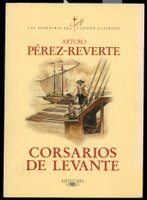
Pérez-Reverte has the Dumas nerve to announce the name of the three forthcoming sequels. I cannot wait. Feeling a tad depressed when I placed my book on the bedroom floor I went downstairs to look for the author's first compilation of his weekly columns for the Spanish literary magazine El Semanal. I doubt that Patente de Corso 1993-1998 (that translates to letter of marque) or its sequel Con Ánimo de Ofender (with a desire to offend) 1998-2001 will be translated into English soon.
I immediately found my most favourite essay, La Novia de D'Artagnan, which is an account of his experience with a young woman at a Buenos Aires bookstore signing. I took the liberty of translating it and hope that Alfaguara (Pérez-Reverte's publisher) does not sue me. When I finished Corsarios De Levante I felt sad that I know nobody with whom I can share my pleasure. I remembered the young girl's plight. Here it is, badly translated by me. But in spite of it I hope you understand my predicament and sadness.
D'Artagnan’s Girl
Arturo Pérez-Reverte
I figured she was in her early 20s. She was in the third or fourth row in that Buenos Aires bookstore where this author was signing. She seemed quiet and shy. She had a backpack full of books and when she finally faced me she took out a tattered copy of The Dumas Club which she had obviously read many times.
“I love D’Artagnan,”” she affirmed, “and the others.” Her voice quivered as if she had just confessed a prohibited or strange passion. She seemed like she was about to say more but didn’t and just stared at the book I now had in my hands. I wrote some warm words on the first page, I chatted with her and from there I shifted my attention to a 60-year-old woman, very handsome, with green eyes which must have been devastating on others in her time. While we chatted about Seville and the bars of Triana, I noticed that the young girl who loved D’Artagnan remained amongst the shelves with her backpack on her shoulder. An hour later, after saying goodbye to the owner and my friends she was still at the door. “I need to show you something,” she said. Her voice trembled, as if the effort to speak to me was difficult. “Please,” she added. We were next to Patio Bullrich, a fashionable mall near the Recoleta, so I felt I would not compromise myself to anything if we sat for five minutes over coffee. I looked at my watch, uncomfortably. I was in doubt.
“It’s too heavy,” the girl said as she pointed at her backpack. I began to laugh, and after a bit she did, too in her timid way. It would be impossible to not have coffee with someone who appeals to you with Porthos’s last words in the Grotto of Locamaria from The Man of the Iron Mask. So the young girl who said she loved D’Artagnan took the seat in front of me but sat on the edge. From her backpack she extracted some extremely used Alexander Dumas novels in old series installments. She had acquired them in old bookstors, she explained. Everything was there, The Three Musketeers, Twenty Years After, and The Vicomte de Bragelonne… She spoke. In spite of shyness, without even lifting her eyes from her books she spoke at length, without stopping, her many hours alone “traveling” the route to Calais, the corridors of the Louvre, fighting Jussac and the cardinal’s guards, flying the napkin at the bastion of St Gervais as a flag and escaping by sheer luck Milady's poisoned Anjou wine.
She knew it all better than I. And since she was a child, she affirmed. To prove it we played a game, a most entertaining game: The size of Constanza Bonacieux’s feet. Porthos’s three surnames. Beufort’s dog’s name. What woman uses the alias Maria Michon. Who is Bascarrat, in which chapter does he break his sword and in what chapter of Bragellone does his son appear. It what street does D’Artagnan live when he is a lieutenant of the musketeers. The only question she was not able to answer, evil Mordaunt’s father’s name, Milady’s secret son.
From the Musketeers we shifted to The Count of Montecristo and Queen Margot. From Dumas we went on to Sabatini, Salgari and the others, between Scaramouche, The Black Corsair and The Prisoner of Zenda. When I mentioned Rupert of Hentzau and Mexican swashbuckler actor Yáñez’s laugh I noticed she was crying. She did it silently and gracefully. Tears were running down her face and falling on the discoloured covers of her old books. I was disturbed so I asked her why she was playing this unpleasant trick on me. She lifted her face. She was serious: “I had never been able to talk about all this with anyone,” she said. I knew this was the truth. After I had paid for the coffees she began to slip her books into her backpack with a sweetness and care. She was careful not to bend the covers as if they were precious objects. She stood up and said, “I wish Ruritania existed.”
“It does,” I answered, “it borders Syldavia to the north and on the south with Castle If.”
She still had tears but I saw her smile. “Then, I will pay for the next coffee,” she said, “If we ever see each other in Zenda.”
After a fleeting kiss I saw her disappear in the crowd with her heavy backpack full of dreams.
Arturo Pérez-Reverte
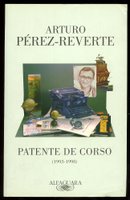
When I thought on how I was going to illustrate this blog I remembered my fading and stained proof in dancer Marthe's files. She was from Montreal. I photographed her because she had the most amazing presence, strength and legs. Even though she is a bit older than the girl cited in Pérez-Reverte's account I think she is just fine.
swashbuckler
more swashbuckler
and more
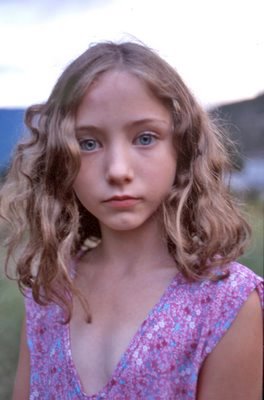
They say children grow up a lot sooner these days. Maybe that's not true and what is true from my point of view is that it took me a long time to do so.
In 1985 Vancouver Magazine dispatched me to photograph an article on boxing written by Jim Christy. It involved boxers like Tony Pep and Michael Olajide. In the end Olajide made the cover. Part of my assignment had me photograph several boxing matches. One thing is to see a boxing film and quite another is to hear the punches and see the blood. With me in all those matches was Vancouver Sun photographer Steve Bosch. He was the paper's boxing expert simply because he chosen years before the night shift. Most boxing matches happen at night. The young, athletic and beautiful Olajide was matched against an older white man who was going to be his cannon fodder and he would allow Olajide to climb up into stardom. The fight was no match and the older man was being devastated by continuous and well placed punches. The man's trainer threw in the towel on to the ring. The old man lowered his guard. Olajide noticed that the judges had not seen this so he swung at the man with a punch that floored him for the ten-count. I was too amazed to take any picture. Next to me Bosch's motor drive whirred away. He got his shot. I didn't. It was then that I gained a great respect for the true newspaper photographer who somehow manages to suppress instincts and emotion to get the job done.

Three weeks ago Lauren, Rebecca, Rosemary and I went to VanDusen and we watched an "opera" that included two male Canada geese and a female. It was a courtship that was being interrupted by a less agressive male who seemed to be desperate. Rebecca informed us that it was unlikely that latecomer would find a partner. She said this with confidence and with a matter of fact coldness. The fight between the two males got vicious. The dominant one was pecking the other with the determination of killing him. We were able to approach the pair to within a foot but we were ignored.

I could have gotten an exciting shot with my Nikon FM-2 in the way that I did not in earlier years capture Olajide's haymaker. But again I could not suppress my emotion. We shouted and threw dirt at the pair until the injured one was able to limp away. Rebecca was silent for the rest of the day. There was a look of sadness, almost agony in her face.
Yesterday we went to see Tiko Kerr's show at the Winsor Gallery. Rebecca was surly and did not want to go. I told her to turn off the computer. She was playing a game. "Make me," she said. I threatened to ground her (I have been given this authority by her parents and it involves a curtailing of computer and TV privileges for whatever length of time I stipulate). But I have rarely followed through with the threat and by the time we arrived at the gallery Rebecca was charmed by Kerr's paintings. Some were extremely large. I spotted the luminously beautiful Barbara Bernath (standing behind a computer in the gallery's back office) who in her youth played drums for such bands as 50% Off which was fronted by no less than Lincoln Clarkes. Rebecca enquired about the self portraits which were collages using hundreds of injection ampules and other medical paraphernalia. Trying to soften the blow I interjected that Kerr had haunted the back alley bins of the Vancouver General Hospital to find the stuff. Barnath interrupted to explain, very clearly, that Kerr who has AIDS, takes a huge amount of medication every day. "The AIDS virus will never go away," she explained to Rebecca. When we left Rebecca asked me (whispering so Lauren would not hear) on Granville, "Is Tiko Kerr g - a - y?" spelling out the word. I answered that he was and that he suffered for many years and had been near death until a special medication was provided only after newspaper articles and a general uproar in Kerr's favour had forced the medical bureaucracy to provide the drug. In the end Rebecca posed by her favourite Tiko Kerr painting which happens to be my favourite, too. It's the one with the float plane and the blue sky. Both of us were hoping it is a Beaver.

I explained that it was nice that a fit and happy Kerr now had sold many paintings for very good money. Bu Kerr's happy ending has come with a realization for Rebecca that life isn't easy and that it is not all fun and games. I think that knowledge is captured in a picture I have been afraid to post here. I took the picture in Lillooet in the fall. Rebecca borrowed Ale's (my daughter and her aunt) top. She wanted to look older. She does. I am sad.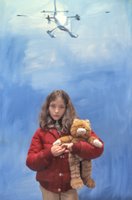
"All mankind is of one author, and is one volume; when one man dies, one chapter is not torn out of the book, but translated into a better language; and every chapter must be so translated...As therefore the bell that rings to a sermon, calls not upon the preacher only, but upon the congregation to come: so this bell calls us all: but how much more me, who am brought so near the door by this sickness....No man is ever an island, entire of itself...any man's death diminishes me, because I am involved in mankind; and therefore send to know for whom the bell tolls; it tolls for thee."
John Donne, Devotions Upon Emergent Occasions, Meditation XVII

For years I have strived for self-sufficiency. When we first arrived in Vancouver I continued with my custom of tuning our VW Beetle. I even had a fine set of spark plug adjusting blades. But it was in Vancouver where folks said,"Alex you make money as a photographer, repairing you car takes you away from making money and the money you save by tuning it yourself is negligible."
In my very large and heavy camera bag I carry a complete set of jeweler's screwdrivers and a pair of needle-nosed pliers. Camera lens and camera body screws tend to loosen up in vibrating airplanes. I avoid a few camera breakdowns with the frequent tightening of little screws.
My problems in my much vaunted self-sufficiency really began when I switched from a Remington Portable No 2 (my grandmother's portable) to a primitive Smith Corona word processor. When I had breakdowns I had to go to Polson's and cajole the repairman to do his job post haste. Suddenly I felt helpless.
Not too long ago I had to scan some transparencies for a client and I had a three hour deadline. Whe I opened my PhotoShop program I was horrified that after a couple of seconds it would close. I found what the expression "corrupted file" meant pronto. This expression now joins "we have issues" and the "computers are down" which signify we are in an area that is beyond our expertise and control. Luckily I also had Paint Shop Pro 8 as a backup and I was able to meet my photo deadline.
I have written here before how as a photographer I have to depend (and I am lucky) on having a support staff. Hungarian Viktor repairs my flash equipment and German Horst Wenzel sees to may cameras. Hungarian Paul Leisz installs programs into my computer, debugs it and every few years takes me to a place on Bridgeport Road where I order up a computer with Paul's suggested components.
Without those three people the latent images of my photography would remain so. Unfortunately my world isn't all that simple considering the intense plumbing problems we have in our house, "You are going to have to rip out that bath tub and that is going to be very..." Suddenly my life got even more stressful and complicated when my blog started deteriorating on Monday. My friend and web designer (he and Chris Botting designed my web page and this blog) Doug Jasinski wrote in an email, "I unleashed this crack that this blog means to you and now I have the responsibility to score you some more by fixing it." Unfortunately Doug Jasinksi and his company Skunkworks are going through a very busy period and my blog perhaps had to wait before it could be looked at. I was desperate.
The blog lost its RSS feed and then I could no longer upload photographs. I found a roundabout method of uploading but it involved no control of placement or size.
In extreme desperation I appealed to the Grand Master Guru Tim Bray. He was in Chicago but promised to look into it. He finally arrived yesterday and sat by my computer. I explained as best as I could. He then opened up one of those boxes in the middle of my monitor and started typing in code stuff that made reading Caesar's Gallic Wars in Latin seem easy. I have never ever seen anybody type such apparent gibberish so quickly. Bray's only complaint was, "Why does your name have to be so long?" The result in the end was that it all became worse. The guru said, "I don't understand Blogger." This was a revealing statement of sorts when you think that many of the elements within Blogger he probably created. Bray went home. Within minutes he called to ask me for my Blogger password. An hour later he called again, "It now works." And work it did. If anything it seemed to have some sort of special web-based lubricant. Everything worked more quickly.
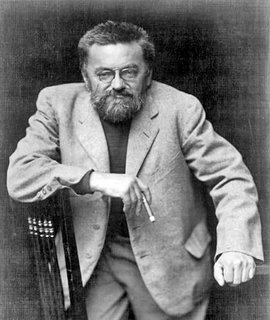
The above makes me think of Charles Proteus Steinmetz (right), the Russian-born American electrical engineer and mathematician who pioneered the concept of alternating current. He and my 10 year-old mother where on the same ocean liner in 1921 when he told her a story. I have heard this story where the person in question was Edison so perhaps it is an aprocryphal one. Suffice to know that the gentle and very short (he suffered from dwarfism and was a hunchback) Steinmetz told my mother that one night he was woken up by a man banging on his door. "We have power problems. We need your help." The man and Steinmetz went to the New York company whence all the electric current that lit the now darkened New York city came from. Steinmetz studied the works and then inserted a fuse he took out of his front pocket. The lights came back on. "I will send you my bill for $1001," he told the relieved man. "Why $1001?" he asked. Steinmetz answered with supreme confidence, "$1 for the fuse and $1000 for knowing were to insert it."
Thinking back on Steinmetz all I can now say to Tim Bray is, "I owe you big, "as my friend Tony Ricci would say.

Last night I finished the latest novel by Cartagena born author Arturo Pérez-Reverte. It is from a series featuring his swashbuckler 17th century soldier of fortune Capitán Don Diego Alatriste. It is the 6th in the series. The first two were somehow translated into English even though these novels are written in a pseudo 17th century Spanish which is quite complex and the stories require a fair knowledge of Spanish history. I never knew, for example that Flanders was to Spain what Vietnam was to the US. In fact most of the gold and silver brought in Spanish galleons from her New World possesions disappeared there.

Pérez-Reverte has the Dumas nerve to announce the name of the three forthcoming sequels. I cannot wait. Feeling a tad depressed when I placed my book on the bedroom floor I went downstairs to look for the author's first compilation of his weekly columns for the Spanish literary magazine El Semanal. I doubt that Patente de Corso 1993-1998 (that translates to letter of marque) or its sequel Con Ánimo de Ofender (with a desire to offend) 1998-2001 will be translated into English soon.
I immediately found my most favourite essay, La Novia de D'Artagnan, which is an account of his experience with a young woman at a Buenos Aires bookstore signing. I took the liberty of translating it and hope that Alfaguara (Pérez-Reverte's publisher) does not sue me. When I finished Corsarios De Levante I felt sad that I know nobody with whom I can share my pleasure. I remembered the young girl's plight. Here it is, badly translated by me. But in spite of it I hope you understand my predicament and sadness.
D'Artagnan’s Girl
Arturo Pérez-Reverte
I figured she was in her early 20s. She was in the third or fourth row in that Buenos Aires bookstore where this author was signing. She seemed quiet and shy. She had a backpack full of books and when she finally faced me she took out a tattered copy of The Dumas Club which she had obviously read many times.
“I love D’Artagnan,”” she affirmed, “and the others.” Her voice quivered as if she had just confessed a prohibited or strange passion. She seemed like she was about to say more but didn’t and just stared at the book I now had in my hands. I wrote some warm words on the first page, I chatted with her and from there I shifted my attention to a 60-year-old woman, very handsome, with green eyes which must have been devastating on others in her time. While we chatted about Seville and the bars of Triana, I noticed that the young girl who loved D’Artagnan remained amongst the shelves with her backpack on her shoulder. An hour later, after saying goodbye to the owner and my friends she was still at the door. “I need to show you something,” she said. Her voice trembled, as if the effort to speak to me was difficult. “Please,” she added. We were next to Patio Bullrich, a fashionable mall near the Recoleta, so I felt I would not compromise myself to anything if we sat for five minutes over coffee. I looked at my watch, uncomfortably. I was in doubt.
“It’s too heavy,” the girl said as she pointed at her backpack. I began to laugh, and after a bit she did, too in her timid way. It would be impossible to not have coffee with someone who appeals to you with Porthos’s last words in the Grotto of Locamaria from The Man of the Iron Mask. So the young girl who said she loved D’Artagnan took the seat in front of me but sat on the edge. From her backpack she extracted some extremely used Alexander Dumas novels in old series installments. She had acquired them in old bookstors, she explained. Everything was there, The Three Musketeers, Twenty Years After, and The Vicomte de Bragelonne… She spoke. In spite of shyness, without even lifting her eyes from her books she spoke at length, without stopping, her many hours alone “traveling” the route to Calais, the corridors of the Louvre, fighting Jussac and the cardinal’s guards, flying the napkin at the bastion of St Gervais as a flag and escaping by sheer luck Milady's poisoned Anjou wine.
She knew it all better than I. And since she was a child, she affirmed. To prove it we played a game, a most entertaining game: The size of Constanza Bonacieux’s feet. Porthos’s three surnames. Beufort’s dog’s name. What woman uses the alias Maria Michon. Who is Bascarrat, in which chapter does he break his sword and in what chapter of Bragellone does his son appear. It what street does D’Artagnan live when he is a lieutenant of the musketeers. The only question she was not able to answer, evil Mordaunt’s father’s name, Milady’s secret son.
From the Musketeers we shifted to The Count of Montecristo and Queen Margot. From Dumas we went on to Sabatini, Salgari and the others, between Scaramouche, The Black Corsair and The Prisoner of Zenda. When I mentioned Rupert of Hentzau and Mexican swashbuckler actor Yáñez’s laugh I noticed she was crying. She did it silently and gracefully. Tears were running down her face and falling on the discoloured covers of her old books. I was disturbed so I asked her why she was playing this unpleasant trick on me. She lifted her face. She was serious: “I had never been able to talk about all this with anyone,” she said. I knew this was the truth. After I had paid for the coffees she began to slip her books into her backpack with a sweetness and care. She was careful not to bend the covers as if they were precious objects. She stood up and said, “I wish Ruritania existed.”
“It does,” I answered, “it borders Syldavia to the north and on the south with Castle If.”
She still had tears but I saw her smile. “Then, I will pay for the next coffee,” she said, “If we ever see each other in Zenda.”
After a fleeting kiss I saw her disappear in the crowd with her heavy backpack full of dreams.
Arturo Pérez-Reverte

When I thought on how I was going to illustrate this blog I remembered my fading and stained proof in dancer Marthe's files. She was from Montreal. I photographed her because she had the most amazing presence, strength and legs. Even though she is a bit older than the girl cited in Pérez-Reverte's account I think she is just fine.
swashbuckler
more swashbuckler
and more
A Fit Tiko Kerr - A Young Boxer - An Older Little Girl
Sunday, April 06, 2008

They say children grow up a lot sooner these days. Maybe that's not true and what is true from my point of view is that it took me a long time to do so.
In 1985 Vancouver Magazine dispatched me to photograph an article on boxing written by Jim Christy. It involved boxers like Tony Pep and Michael Olajide. In the end Olajide made the cover. Part of my assignment had me photograph several boxing matches. One thing is to see a boxing film and quite another is to hear the punches and see the blood. With me in all those matches was Vancouver Sun photographer Steve Bosch. He was the paper's boxing expert simply because he chosen years before the night shift. Most boxing matches happen at night. The young, athletic and beautiful Olajide was matched against an older white man who was going to be his cannon fodder and he would allow Olajide to climb up into stardom. The fight was no match and the older man was being devastated by continuous and well placed punches. The man's trainer threw in the towel on to the ring. The old man lowered his guard. Olajide noticed that the judges had not seen this so he swung at the man with a punch that floored him for the ten-count. I was too amazed to take any picture. Next to me Bosch's motor drive whirred away. He got his shot. I didn't. It was then that I gained a great respect for the true newspaper photographer who somehow manages to suppress instincts and emotion to get the job done.

Three weeks ago Lauren, Rebecca, Rosemary and I went to VanDusen and we watched an "opera" that included two male Canada geese and a female. It was a courtship that was being interrupted by a less agressive male who seemed to be desperate. Rebecca informed us that it was unlikely that latecomer would find a partner. She said this with confidence and with a matter of fact coldness. The fight between the two males got vicious. The dominant one was pecking the other with the determination of killing him. We were able to approach the pair to within a foot but we were ignored.

I could have gotten an exciting shot with my Nikon FM-2 in the way that I did not in earlier years capture Olajide's haymaker. But again I could not suppress my emotion. We shouted and threw dirt at the pair until the injured one was able to limp away. Rebecca was silent for the rest of the day. There was a look of sadness, almost agony in her face.
Yesterday we went to see Tiko Kerr's show at the Winsor Gallery. Rebecca was surly and did not want to go. I told her to turn off the computer. She was playing a game. "Make me," she said. I threatened to ground her (I have been given this authority by her parents and it involves a curtailing of computer and TV privileges for whatever length of time I stipulate). But I have rarely followed through with the threat and by the time we arrived at the gallery Rebecca was charmed by Kerr's paintings. Some were extremely large. I spotted the luminously beautiful Barbara Bernath (standing behind a computer in the gallery's back office) who in her youth played drums for such bands as 50% Off which was fronted by no less than Lincoln Clarkes. Rebecca enquired about the self portraits which were collages using hundreds of injection ampules and other medical paraphernalia. Trying to soften the blow I interjected that Kerr had haunted the back alley bins of the Vancouver General Hospital to find the stuff. Barnath interrupted to explain, very clearly, that Kerr who has AIDS, takes a huge amount of medication every day. "The AIDS virus will never go away," she explained to Rebecca. When we left Rebecca asked me (whispering so Lauren would not hear) on Granville, "Is Tiko Kerr g - a - y?" spelling out the word. I answered that he was and that he suffered for many years and had been near death until a special medication was provided only after newspaper articles and a general uproar in Kerr's favour had forced the medical bureaucracy to provide the drug. In the end Rebecca posed by her favourite Tiko Kerr painting which happens to be my favourite, too. It's the one with the float plane and the blue sky. Both of us were hoping it is a Beaver.

I explained that it was nice that a fit and happy Kerr now had sold many paintings for very good money. Bu Kerr's happy ending has come with a realization for Rebecca that life isn't easy and that it is not all fun and games. I think that knowledge is captured in a picture I have been afraid to post here. I took the picture in Lillooet in the fall. Rebecca borrowed Ale's (my daughter and her aunt) top. She wanted to look older. She does. I am sad.

Grand Master Guru Tim Bray & Charles Proteus Steinmetz
Saturday, April 05, 2008
"All mankind is of one author, and is one volume; when one man dies, one chapter is not torn out of the book, but translated into a better language; and every chapter must be so translated...As therefore the bell that rings to a sermon, calls not upon the preacher only, but upon the congregation to come: so this bell calls us all: but how much more me, who am brought so near the door by this sickness....No man is ever an island, entire of itself...any man's death diminishes me, because I am involved in mankind; and therefore send to know for whom the bell tolls; it tolls for thee."
John Donne, Devotions Upon Emergent Occasions, Meditation XVII

For years I have strived for self-sufficiency. When we first arrived in Vancouver I continued with my custom of tuning our VW Beetle. I even had a fine set of spark plug adjusting blades. But it was in Vancouver where folks said,"Alex you make money as a photographer, repairing you car takes you away from making money and the money you save by tuning it yourself is negligible."
In my very large and heavy camera bag I carry a complete set of jeweler's screwdrivers and a pair of needle-nosed pliers. Camera lens and camera body screws tend to loosen up in vibrating airplanes. I avoid a few camera breakdowns with the frequent tightening of little screws.
My problems in my much vaunted self-sufficiency really began when I switched from a Remington Portable No 2 (my grandmother's portable) to a primitive Smith Corona word processor. When I had breakdowns I had to go to Polson's and cajole the repairman to do his job post haste. Suddenly I felt helpless.
Not too long ago I had to scan some transparencies for a client and I had a three hour deadline. Whe I opened my PhotoShop program I was horrified that after a couple of seconds it would close. I found what the expression "corrupted file" meant pronto. This expression now joins "we have issues" and the "computers are down" which signify we are in an area that is beyond our expertise and control. Luckily I also had Paint Shop Pro 8 as a backup and I was able to meet my photo deadline.
I have written here before how as a photographer I have to depend (and I am lucky) on having a support staff. Hungarian Viktor repairs my flash equipment and German Horst Wenzel sees to may cameras. Hungarian Paul Leisz installs programs into my computer, debugs it and every few years takes me to a place on Bridgeport Road where I order up a computer with Paul's suggested components.
Without those three people the latent images of my photography would remain so. Unfortunately my world isn't all that simple considering the intense plumbing problems we have in our house, "You are going to have to rip out that bath tub and that is going to be very..." Suddenly my life got even more stressful and complicated when my blog started deteriorating on Monday. My friend and web designer (he and Chris Botting designed my web page and this blog) Doug Jasinski wrote in an email, "I unleashed this crack that this blog means to you and now I have the responsibility to score you some more by fixing it." Unfortunately Doug Jasinksi and his company Skunkworks are going through a very busy period and my blog perhaps had to wait before it could be looked at. I was desperate.
The blog lost its RSS feed and then I could no longer upload photographs. I found a roundabout method of uploading but it involved no control of placement or size.
In extreme desperation I appealed to the Grand Master Guru Tim Bray. He was in Chicago but promised to look into it. He finally arrived yesterday and sat by my computer. I explained as best as I could. He then opened up one of those boxes in the middle of my monitor and started typing in code stuff that made reading Caesar's Gallic Wars in Latin seem easy. I have never ever seen anybody type such apparent gibberish so quickly. Bray's only complaint was, "Why does your name have to be so long?" The result in the end was that it all became worse. The guru said, "I don't understand Blogger." This was a revealing statement of sorts when you think that many of the elements within Blogger he probably created. Bray went home. Within minutes he called to ask me for my Blogger password. An hour later he called again, "It now works." And work it did. If anything it seemed to have some sort of special web-based lubricant. Everything worked more quickly.

The above makes me think of Charles Proteus Steinmetz (right), the Russian-born American electrical engineer and mathematician who pioneered the concept of alternating current. He and my 10 year-old mother where on the same ocean liner in 1921 when he told her a story. I have heard this story where the person in question was Edison so perhaps it is an aprocryphal one. Suffice to know that the gentle and very short (he suffered from dwarfism and was a hunchback) Steinmetz told my mother that one night he was woken up by a man banging on his door. "We have power problems. We need your help." The man and Steinmetz went to the New York company whence all the electric current that lit the now darkened New York city came from. Steinmetz studied the works and then inserted a fuse he took out of his front pocket. The lights came back on. "I will send you my bill for $1001," he told the relieved man. "Why $1001?" he asked. Steinmetz answered with supreme confidence, "$1 for the fuse and $1000 for knowing were to insert it."
Thinking back on Steinmetz all I can now say to Tim Bray is, "I owe you big, "as my friend Tony Ricci would say.
Friday, April 04, 2008
Graham Walker and I attended an Early Music Vancouver concert of J.S. Bach's 4 Orchestral Suites played by the Belgian group Il Fondamento. It is not often that one gets to listen and see a large 18 piece baroque instrument orchestra so Walker and I sat in the front row to get a full (loud) sound. All performers were dressed in black and my eyes lingered on the female bassoonist who was dressed in an old fashioned black and very frilly dress. She was wearing black hose and black flat shoes. I could get a glimpse of the shoes and the ankles and I felt like a naughty Victorian gentleman. I looked at the faces of the musicians, I froze them in my mind like a Daguerreotype camera and tried to imagine them in the 19th century or even further back as Flemish portrait paintings. I lingered again on the unlikely named bassoonist. The program said she was Alain De Rijckere. I imagined her as a Vermeer by a window, with little on, gazing with pride of purpose.
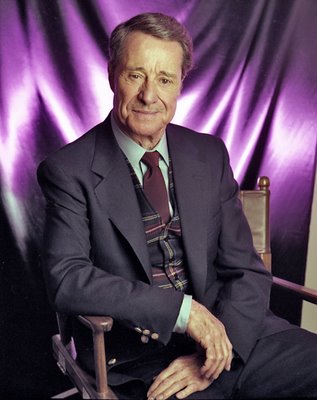
After the concert Walker and I had a chat with the very friendly violinist Johan Van Aken. Being able to chat with musicians is one of the additional pleasures of Early Music Vancouver concerts. It's far more intimate than seeing 19th century clothed members of large orchestras up on a stage and to be subjected to the stiff protocol of the concertmaster shaking hands with the director. An older man, sitting on the right with his oboe, Paul Dombrecht was the director. In the Bach suites without oboes the first violinist Dirk Vandaele nodded his head in direction.
Van Aken told us that he had done many of the transcriptions and annotations to the Il Fundamento CD that both Walker and I bought. The CD featured Juan Crisóstomo de Arriaga Orchestral Works 1818- 1824. The Basque composer died in Paris when he was 20. The prospect of listening to new music (for us anyway) from an unknown composer (to us) was exciting.
I dared in the end to mention to Van Aken my infatuation with the bassoonist and I enquired how a woman could be called Alain. "No, she is not Alain. She is an Australian called Jane Gower. If you want I will introduce you to her." For a few seconds my visions of the Flemish painting (as replicated with a camera) came crashing down but I quickly shifted to an Australian outback. But I felt too shy to accept Van Aken's offer and, of course I now regret it.
What does Il Fundamento, a formerly Flemish but now Australian bassoonist, and a long forgotten Basque composer of the early 19th century have to do with Don Ameche?
For one while this blog is broken and I have a limited ability to post pictures with some sort of control I enjoy posting large photos as they appear large. For most people who might read this blog today they will probably not know who Ameche is. And that is perfectly fine. But just freeze your sight on the man and perhaps imagine him as a movie actor playing D'Artagnan with foil in hand. You could be right or you could be wrong. That's not important. It's the imagining that is.
As I played Il Fondamento's Juan Crisóstomo de Arriaga I tried to imagine him at his deathbed (he died of tuberculosis) with his friend Spanish pianist Mateo Pérez de Albéniz bedside. When Arriaga died Albéniz sent the composer's belongings to his home in Bilbao and wrote a letter to his father.
Early Music Vancouver's next concert
Graham Walker and I attended an Early Music Vancouver concert of J.S. Bach's 4 Orchestral Suites played by the Belgian group Il Fondamento. It is not often that one gets to listen and see a large 18 piece baroque instrument orchestra so Walker and I sat in the front row to get a full (loud) sound. All performers were dressed in black and my eyes lingered on the female bassoonist who was dressed in an old fashioned black and very frilly dress. She was wearing black hose and black flat shoes. I could get a glimpse of the shoes and the ankles and I felt like a naughty Victorian gentleman. I looked at the faces of the musicians, I froze them in my mind like a Daguerreotype camera and tried to imagine them in the 19th century or even further back as Flemish portrait paintings. I lingered again on the unlikely named bassoonist. The program said she was Alain De Rijckere. I imagined her as a Vermeer by a window, with little on, gazing with pride of purpose.

After the concert Walker and I had a chat with the very friendly violinist Johan Van Aken. Being able to chat with musicians is one of the additional pleasures of Early Music Vancouver concerts. It's far more intimate than seeing 19th century clothed members of large orchestras up on a stage and to be subjected to the stiff protocol of the concertmaster shaking hands with the director. An older man, sitting on the right with his oboe, Paul Dombrecht was the director. In the Bach suites without oboes the first violinist Dirk Vandaele nodded his head in direction.
Van Aken told us that he had done many of the transcriptions and annotations to the Il Fundamento CD that both Walker and I bought. The CD featured Juan Crisóstomo de Arriaga Orchestral Works 1818- 1824. The Basque composer died in Paris when he was 20. The prospect of listening to new music (for us anyway) from an unknown composer (to us) was exciting.
I dared in the end to mention to Van Aken my infatuation with the bassoonist and I enquired how a woman could be called Alain. "No, she is not Alain. She is an Australian called Jane Gower. If you want I will introduce you to her." For a few seconds my visions of the Flemish painting (as replicated with a camera) came crashing down but I quickly shifted to an Australian outback. But I felt too shy to accept Van Aken's offer and, of course I now regret it.
What does Il Fundamento, a formerly Flemish but now Australian bassoonist, and a long forgotten Basque composer of the early 19th century have to do with Don Ameche?
For one while this blog is broken and I have a limited ability to post pictures with some sort of control I enjoy posting large photos as they appear large. For most people who might read this blog today they will probably not know who Ameche is. And that is perfectly fine. But just freeze your sight on the man and perhaps imagine him as a movie actor playing D'Artagnan with foil in hand. You could be right or you could be wrong. That's not important. It's the imagining that is.
As I played Il Fondamento's Juan Crisóstomo de Arriaga I tried to imagine him at his deathbed (he died of tuberculosis) with his friend Spanish pianist Mateo Pérez de Albéniz bedside. When Arriaga died Albéniz sent the composer's belongings to his home in Bilbao and wrote a letter to his father.
Early Music Vancouver's next concert
Thursday, April 03, 2008
Last night Rosemary and I attended the opening of the Arts Club Theatre Company production of Michele Riml's Poster Boys at the Granville Island Stage. Scott Bellis, convincingly plays the older man who in his youth came out and dumped the ad agency executive bride at the altar and Luke Camilleri is the young man who without being ambivalent about his sexuality wants to be like his boss, the powerful ad agency executive played by Lois Anderson. Both Camilleri and Bellis are very good but they cannot compete with Anderson or Daniel Arnold who plays the younger man and the other woman in the play. Both Anderson and Arnold are superb dramatic actors, but they also shine as comedians. Below is a profile on Lois Anderson that has just appeared in the April issue of VLM (Vancouver Lifestyle Magazine).
What can I say about a magazine editor that responds to my, "Bob [Mercer] we need a profile on a fine actress," with, "Alex, do it."
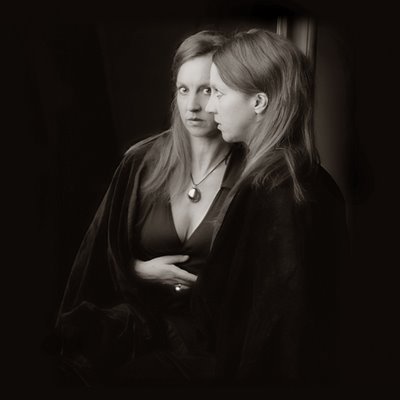
Lois Anderson
My granddaughter Rebecca and I watched in 2002 the Leaky Heaven Circus’s not too reverential nativity play Birthday Boy. That’s when we discovered Lois Anderson’s playing St. Joseph to a black Virgin Mary. We laughed. Since then, I have watched Anderson in dramatic roles including last year’s Trout Stanley where she went from comedy to drama and ended up sexy. She won a Jessie Richardson Award (five Jessies in all), in 2007, playing a 17 year-old Salome in the Leaky Heaven Circus production of Salome. While Anderson denied that she is sexy, she did tell me during our photo session and interview in my studio, “I am 42 years old right now and I had to seduce King Herod as a 17 year-old. We pulled it off.”
Anderson is a sculptor of sorts. “I have been doing this since I was 24. I can sculpt my career. I can seek out comedy and drama. I love choosing the next part and having to do something that I have not done before. This is how I’ve lasted.” Besides sculpture, Anderson has toured France in a circus knife board act (on the receiving end) and lists circus silks and the trapeze as additional skills. Her two daughters, Anuska (13) and Elena (10) have had a trapeze in their room most of their life until the current landlord objected to making holes in the ceiling.
While Anderson played Dorothy in the Wizard of Oz in Grade 6 it wasn’t until she was at an archeological dig in the Negev Desert when she was 24 that she decided to pursue acting.
Lois Anderson will be appearing in the Arts Club Theatre Company’s production of Poster Boys directed by Andrew McIlroy which is based on the true story (written by Michele Riml) of two gay men who posed for a series of VanCity ads (that were meant to be gay) in the 90s in Vancouver. The play opens March 27 (until April 26) at the Granville Island Stage.
© 2008 VLM/Alex Waterhouse-Hayward
When Daniel Arnold showed up in my studio in the fall of 2007 for a photograph for the Georgia Straight I was particularly impressed by an actor who had a way of looking right at me. He had a smile. I captured that smile but I would rather show Arnold's serious side here. He was so easy to photograph that I took one Polaroid and then four exposures with my medium format camera. The man that plays the sensitive young gay architect and Lois Anderson's character Caroline's alter-ego (dressed as a woman with a red wig and sunglasses, and intelligently underplayed) is a completely different man from the man who was in my studio. It just shows Arnold's superb range. Poster Boys is a comedy (I laughed lots and as loudly as the man who was on my right (lawyer Christopher Dafoe). It is also a tragedy of sorts. All in all Rosemary and I went home satisfied and Arnold and Anderson's performances will linger in our memory.

Inside joke, my friend Larry will be surprised they changed his name to Yvette.
It would seem that I have an unplanned blogging vacation. I am unable to post photographs with any kind of regularity and words are iffy, too. The problem with Blogger, is that they are owned by Google and they are now so huge that there is no support staff either by phone or by email. This morning I called Google in California and had the luck to talk to a human being. The moment I mentioned the word blogger, he hung up. As soon as it is feasible I will be switching my blog to WordPress. Until then I cannot forsee when I will blog here again.
I seem to be able to post photographs that I have up in Photobucket.com. The only problem is that I am unable to size them or to move them around so that copy surrounds the photographs. But at least I can provide a needed service to one my fans who has demanded to see Zanna Downes's fishnets. Here they are:
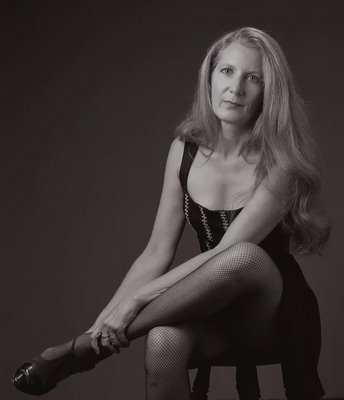
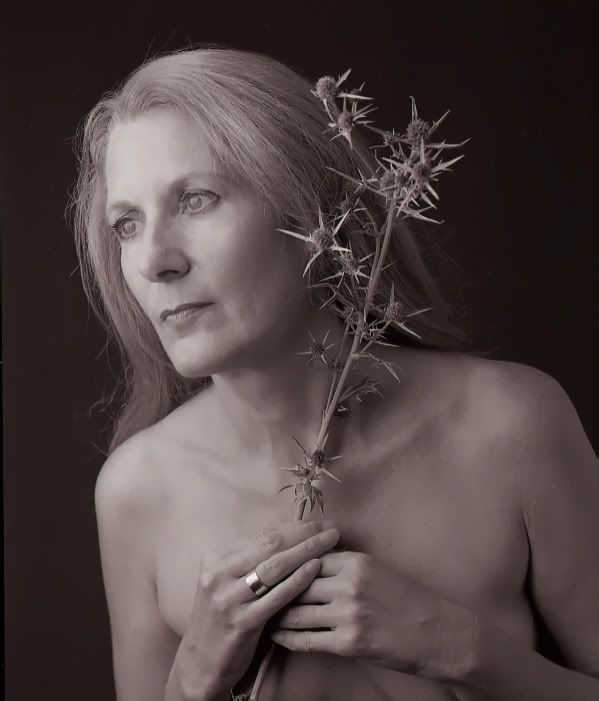
This blog might not post. As it is I am unable to insert photographs. It's another Blogger problem that goes unannounced. If the issues resolve later I will post with pictures.
Today I begin my first class of a 10-week (every Tuesday) at Focal Point called The Contemporary Nude Portrait. I teach it at least twice a year and it seems very popular. I have been thinking this morning of my class notes and what to compose for the class. Today it is a lecture and then we alternate shooting sessions one week with lecture on the next. Suddenly I thought of Zanna Downes. Below is my story on this wonderful woman.
During my tango dancing days, some years ago one of my favourite partners was one that intimidated me with her precision and her matter of fact, "This should be easy for you, Alex," which of course it wasn't. Zanna (short for Alexandra) Downes was a beautiful woman with the most exciting legs this side of Marlene Dietrich, particularly when Downes wore her trademark fishnets. Another intimidating factor was her Miss Moneypenny accent. There was no way I could be James to her Jane.
One day while dancing (you should never talk while dancing the Argentine tango) I put forward my frustration at wanting to find a woman over 50 (a definitely over 50) who would pose for me undraped. "I am tired of taking photographs of perfectly perfect young women who are to young to show character. Downes just whispered in my ear, I'll pose for you. And this she did.
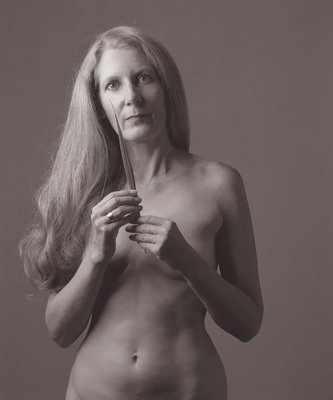
Last night Rosemary and I attended the opening of the Arts Club Theatre Company production of Michele Riml's Poster Boys at the Granville Island Stage. Scott Bellis, convincingly plays the older man who in his youth came out and dumped the ad agency executive bride at the altar and Luke Camilleri is the young man who without being ambivalent about his sexuality wants to be like his boss, the powerful ad agency executive played by Lois Anderson. Both Camilleri and Bellis are very good but they cannot compete with Anderson or Daniel Arnold who plays the younger man and the other woman in the play. Both Anderson and Arnold are superb dramatic actors, but they also shine as comedians. Below is a profile on Lois Anderson that has just appeared in the April issue of VLM (Vancouver Lifestyle Magazine).
What can I say about a magazine editor that responds to my, "Bob [Mercer] we need a profile on a fine actress," with, "Alex, do it."

Lois Anderson
My granddaughter Rebecca and I watched in 2002 the Leaky Heaven Circus’s not too reverential nativity play Birthday Boy. That’s when we discovered Lois Anderson’s playing St. Joseph to a black Virgin Mary. We laughed. Since then, I have watched Anderson in dramatic roles including last year’s Trout Stanley where she went from comedy to drama and ended up sexy. She won a Jessie Richardson Award (five Jessies in all), in 2007, playing a 17 year-old Salome in the Leaky Heaven Circus production of Salome. While Anderson denied that she is sexy, she did tell me during our photo session and interview in my studio, “I am 42 years old right now and I had to seduce King Herod as a 17 year-old. We pulled it off.”
Anderson is a sculptor of sorts. “I have been doing this since I was 24. I can sculpt my career. I can seek out comedy and drama. I love choosing the next part and having to do something that I have not done before. This is how I’ve lasted.” Besides sculpture, Anderson has toured France in a circus knife board act (on the receiving end) and lists circus silks and the trapeze as additional skills. Her two daughters, Anuska (13) and Elena (10) have had a trapeze in their room most of their life until the current landlord objected to making holes in the ceiling.
While Anderson played Dorothy in the Wizard of Oz in Grade 6 it wasn’t until she was at an archeological dig in the Negev Desert when she was 24 that she decided to pursue acting.
Lois Anderson will be appearing in the Arts Club Theatre Company’s production of Poster Boys directed by Andrew McIlroy which is based on the true story (written by Michele Riml) of two gay men who posed for a series of VanCity ads (that were meant to be gay) in the 90s in Vancouver. The play opens March 27 (until April 26) at the Granville Island Stage.
© 2008 VLM/Alex Waterhouse-Hayward
When Daniel Arnold showed up in my studio in the fall of 2007 for a photograph for the Georgia Straight I was particularly impressed by an actor who had a way of looking right at me. He had a smile. I captured that smile but I would rather show Arnold's serious side here. He was so easy to photograph that I took one Polaroid and then four exposures with my medium format camera. The man that plays the sensitive young gay architect and Lois Anderson's character Caroline's alter-ego (dressed as a woman with a red wig and sunglasses, and intelligently underplayed) is a completely different man from the man who was in my studio. It just shows Arnold's superb range. Poster Boys is a comedy (I laughed lots and as loudly as the man who was on my right (lawyer Christopher Dafoe). It is also a tragedy of sorts. All in all Rosemary and I went home satisfied and Arnold and Anderson's performances will linger in our memory.

Inside joke, my friend Larry will be surprised they changed his name to Yvette.
No Support From Blogger. An Unplanned Blog Vacation
Wednesday, April 02, 2008
It would seem that I have an unplanned blogging vacation. I am unable to post photographs with any kind of regularity and words are iffy, too. The problem with Blogger, is that they are owned by Google and they are now so huge that there is no support staff either by phone or by email. This morning I called Google in California and had the luck to talk to a human being. The moment I mentioned the word blogger, he hung up. As soon as it is feasible I will be switching my blog to WordPress. Until then I cannot forsee when I will blog here again.
I seem to be able to post photographs that I have up in Photobucket.com. The only problem is that I am unable to size them or to move them around so that copy surrounds the photographs. But at least I can provide a needed service to one my fans who has demanded to see Zanna Downes's fishnets. Here they are:

Zanna Downes - Miss Moneypenny's Fishnets
Tuesday, April 01, 2008

This blog might not post. As it is I am unable to insert photographs. It's another Blogger problem that goes unannounced. If the issues resolve later I will post with pictures.
Today I begin my first class of a 10-week (every Tuesday) at Focal Point called The Contemporary Nude Portrait. I teach it at least twice a year and it seems very popular. I have been thinking this morning of my class notes and what to compose for the class. Today it is a lecture and then we alternate shooting sessions one week with lecture on the next. Suddenly I thought of Zanna Downes. Below is my story on this wonderful woman.
During my tango dancing days, some years ago one of my favourite partners was one that intimidated me with her precision and her matter of fact, "This should be easy for you, Alex," which of course it wasn't. Zanna (short for Alexandra) Downes was a beautiful woman with the most exciting legs this side of Marlene Dietrich, particularly when Downes wore her trademark fishnets. Another intimidating factor was her Miss Moneypenny accent. There was no way I could be James to her Jane.
One day while dancing (you should never talk while dancing the Argentine tango) I put forward my frustration at wanting to find a woman over 50 (a definitely over 50) who would pose for me undraped. "I am tired of taking photographs of perfectly perfect young women who are to young to show character. Downes just whispered in my ear, I'll pose for you. And this she did.







